JKBOSE 10th Class Maths Solutions chapter – 7 Coordinate Geometry
JKBOSE 10th Class Maths Solutions chapter – 7 Coordinate Geometry
J&K 10th Class Maths Solutions chapter – 7 Coordinate Geometry
Jammu & Kashmir State Board JKBOSE 10th Class Maths Solutions
INTRODUCTION
In class IX, you have studied that to locate the position of a point on a plane, we require a pair of coordinate axes. The distance of a point from the y-axis is called its x-coordinate, or abscissa. The distance of a point from the x-axis is called its y-coordinate, or ordinate. The coordinates of a point on the x-axis are of the form (x, 0) and of a point on the y-axis are of the form (0, y).
Also, you have seen that a linear equation in two variables of the form ax + by + c = 0, a, b are not simultaneously zero, when represented graphically, gives a straight line. Further in Chapter 4, you have seen the graph of y = ax² + bx + c (a ‡ 0), is a parabola. In fact, coordinate geometry has been developed as an algebraic tool for studying geometry of figures. It helps us to study geometry using algebra, and understand algebra with the help of geometry. Because of this, coordinate geometry is widely applied in various fields such as physics, engineering, navigation, seismology and art.
TEXT BOOK EXERCISE 7.1
Q. 1. Find the distance between the following pairs of points:
(i) (2, 3); (4,1)
(ii) (-5, 7); (-1, 3)
(iii) (a, b); (-a, – b).
Solution. (i) Given points are: (2, 3); (4,1)
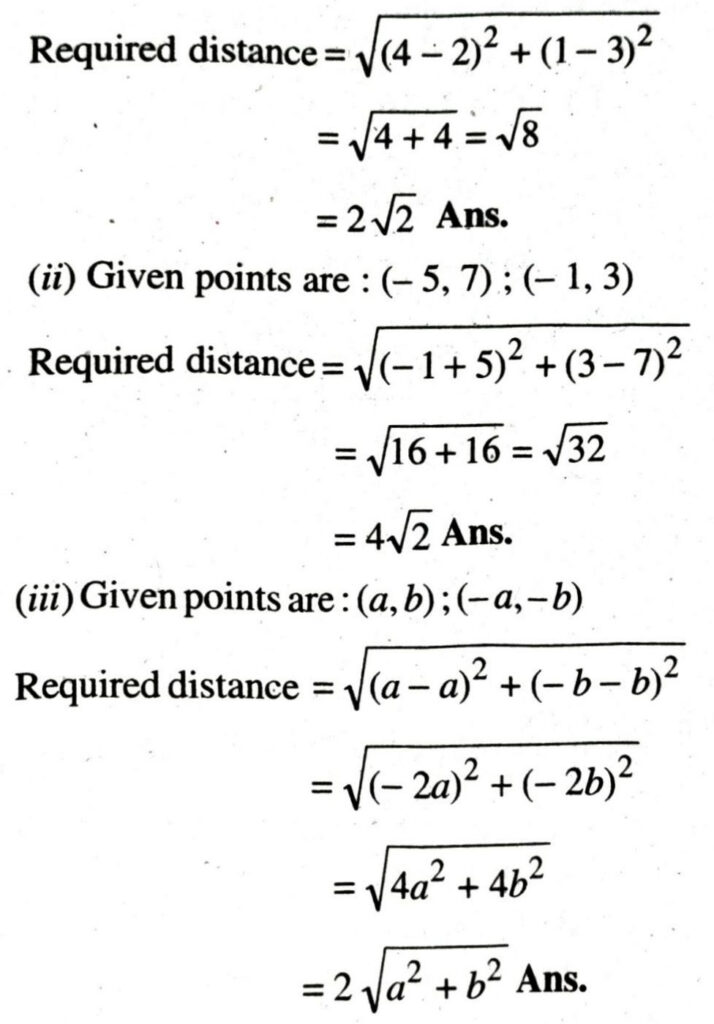
Q. 2. Find the distance between the points (0, 0) and (36, 15). Can you now find the distance between the two towns A and B discussed in section 7.2.
Solution. Given points are: A (0, 0) and B (36, 15)

According to Section 7.2
Draw the distinct points A (0, 0) and B (36, 15) as shown in figure.
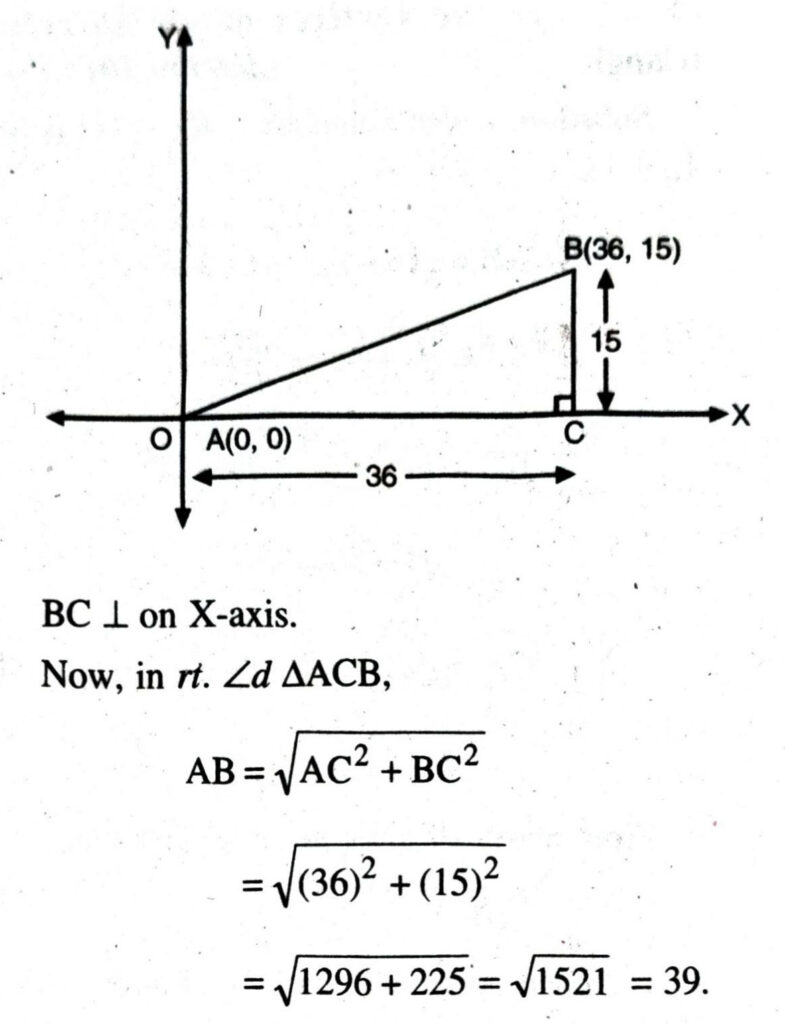
Hence, required distance between points is 39. Ans.
Q. 3. Determine if the points (1, 5), (2, 3) and (-2,- 11) are collinear.
Solution. Given point are: A (1, 5); B (2, 3) and (-2,- 11).
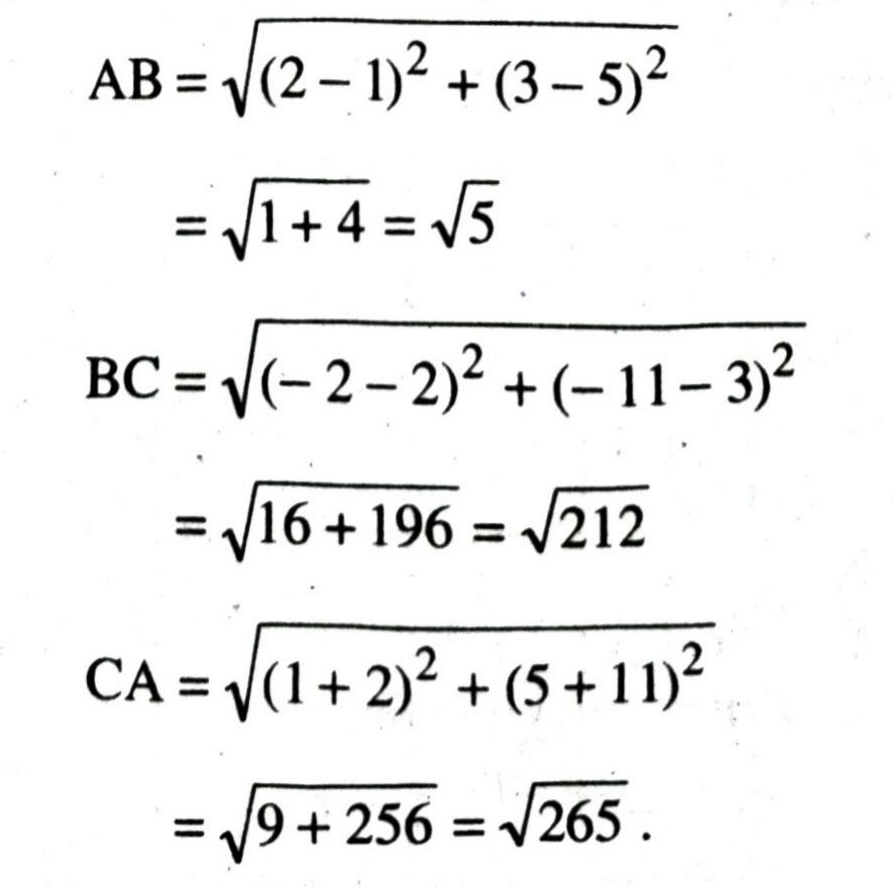
From above distances, it is clear that sum of any two is not equal to third one.
Hence, given points are not collinear. Ans.
Q. 4. Check whether (5,-2); (6, 4) and (7,-2) are the vertices of an isosceles triangle.
Solution. Given points be A (5,-2); B (6, 4) and C (7,-2).
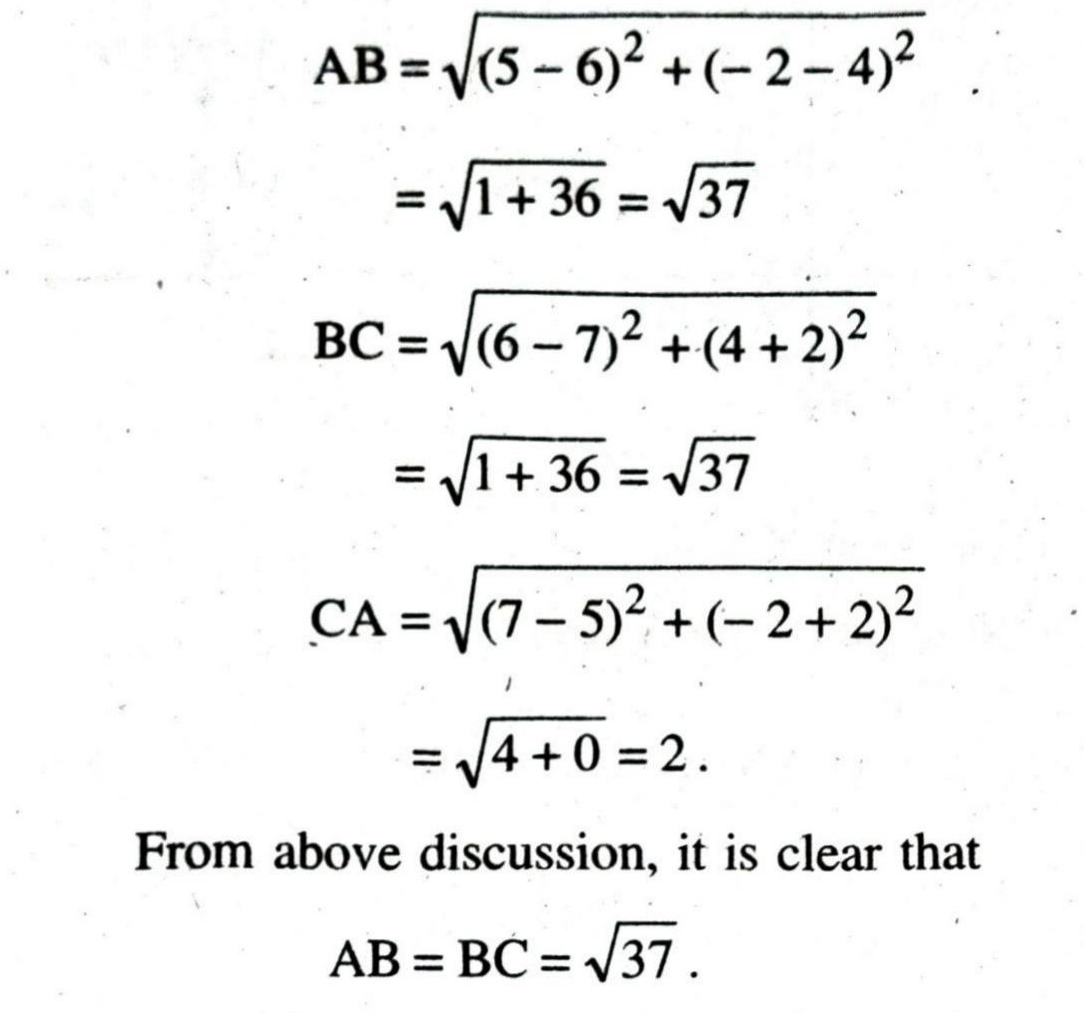
∴ Given points are vertices of an isosceles triangle. Ans.
Q. 5. In a classroom, 4 friends are seated at the points A, B, C and D as shown in fig. Champa and Chameli walk into the class and after observing for a few minutes Champa asks Chameli, “Don’t you think ABCD is a square”? Chameli disagrees. Using distance formula, find which of them is correct, and why ?
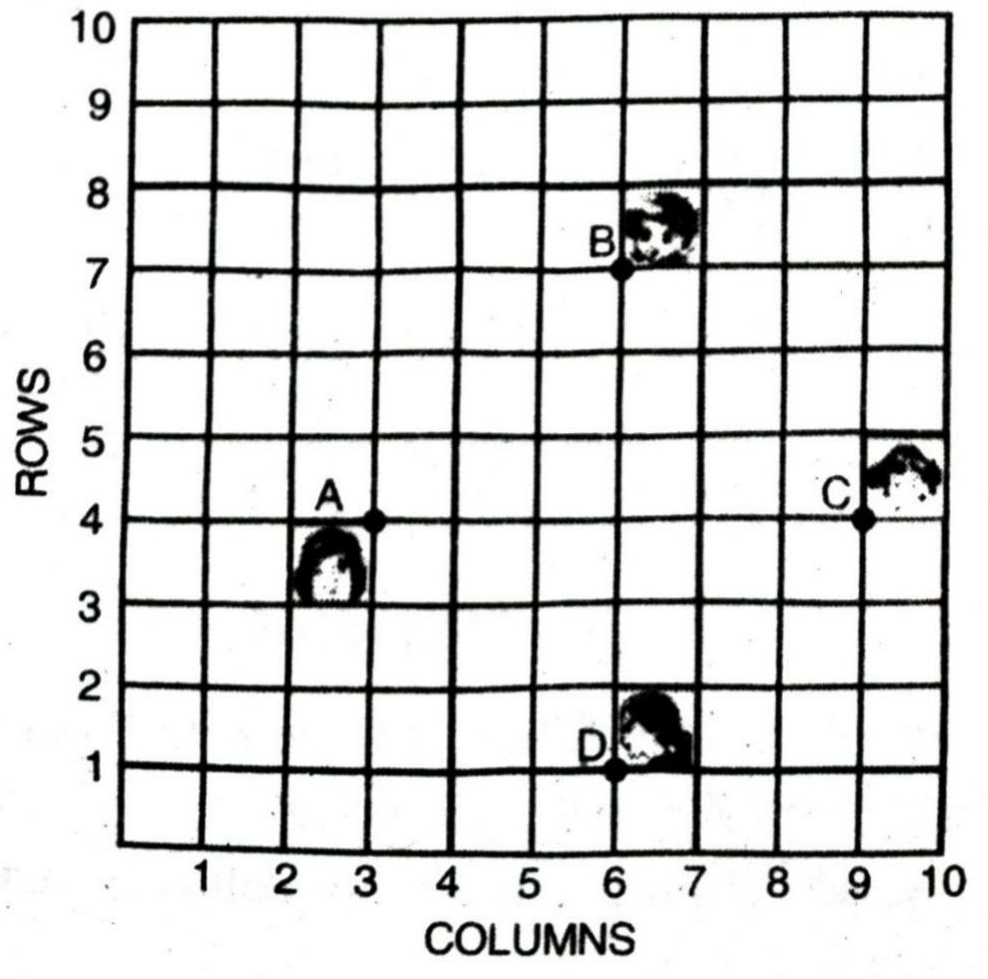
Solution. In the given diagram, the vertices of given points are: A (3, 4); B (6, 7); C (9,4) and D (6, 1).
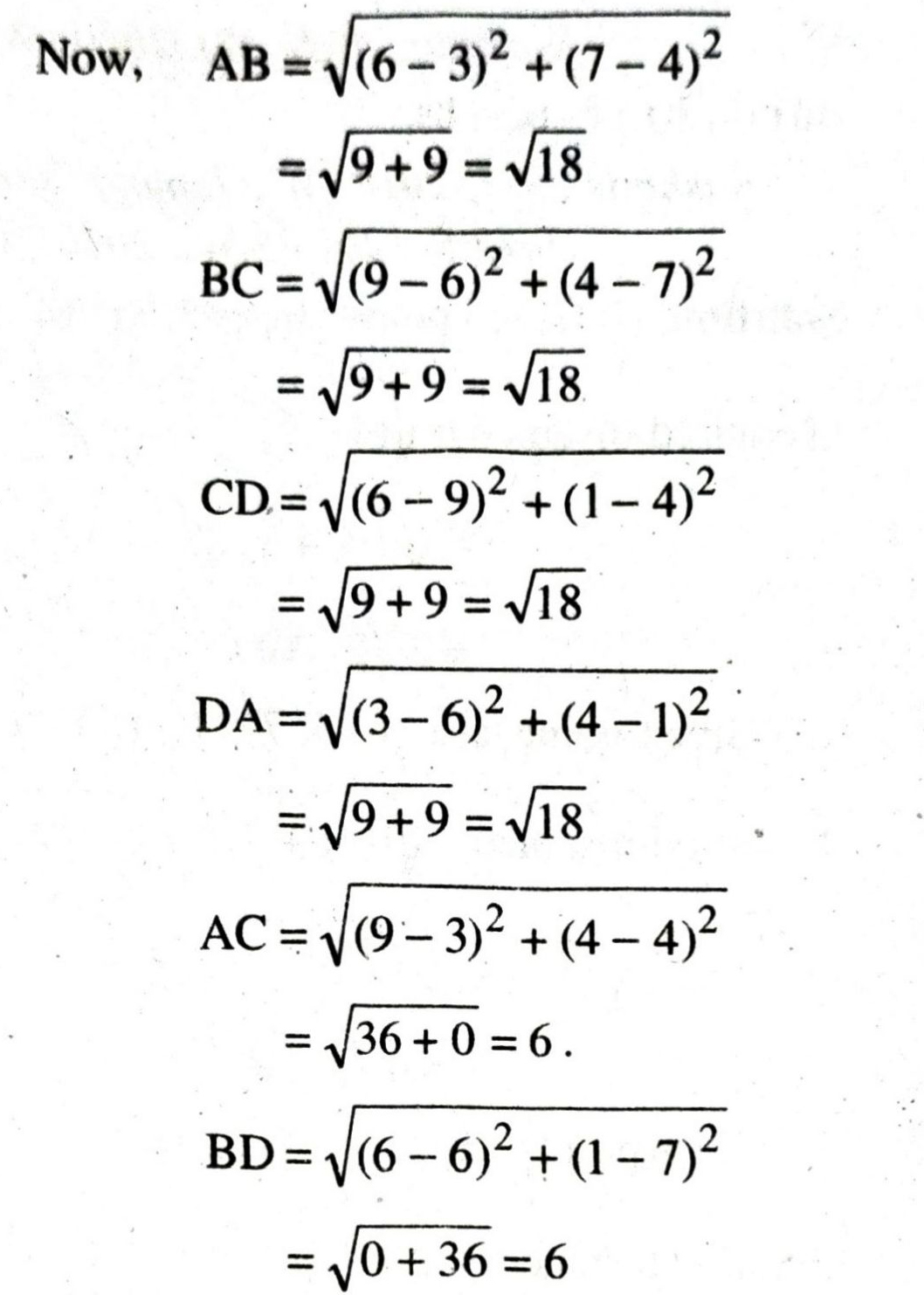
From above discussion, it is clear that
AB = BC = CD = DA = √18 and AC = BD = 6.
∴ ABCD formed a square and Champa is correct about her thinking. Ans.
Q. 6. Name the type of quadrilateral formed, if any, by the following points, and give reasons for your answer :
(i) (-1, – 2), (1, 0), (- 1, 2), (- 3,0)
(ii) (-3, 5), (3, 1), (0, 3), (- 1,-4)
(iii) (4, 5), (7, 6), (4, 3), (1, 2).
Solution. (i) Given points be A (-1,-2); B (1, 0); C (- 1, 2)
and D (-3, 0).
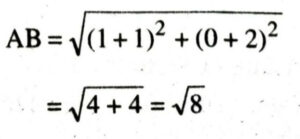
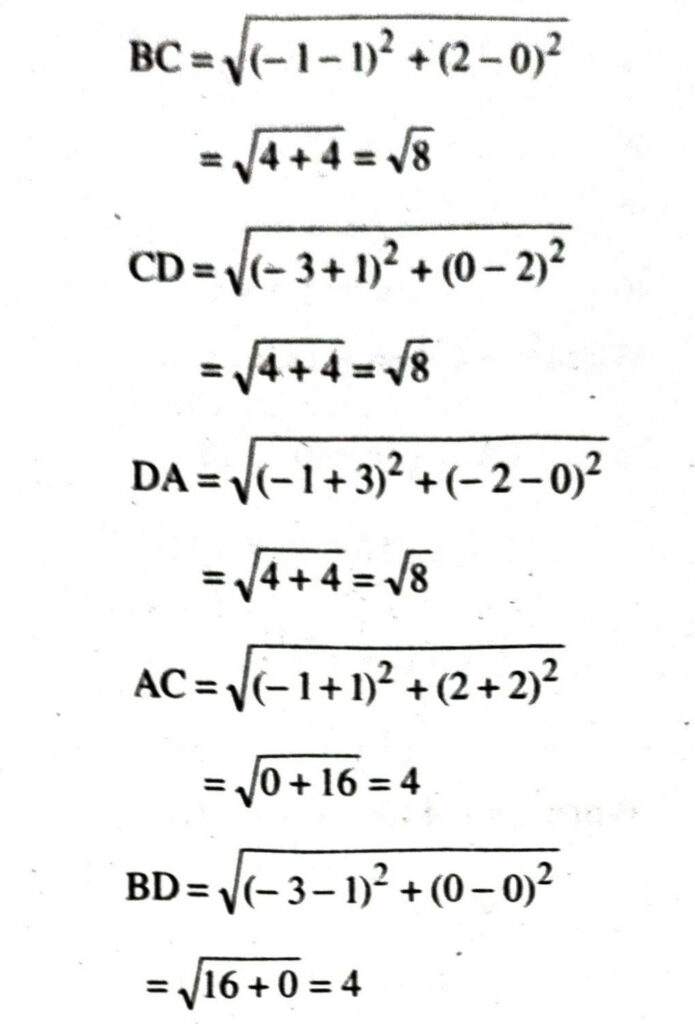
From above discussion, it is clear that
AB = BC = CD = DA = √8 and AC = BD = 4.
Hence, given quadrilateral ABCD is a square. Ans.
(ii) Given points be A (-3, 5); B (3, 1); C (0, 3) and D (-1, – 4)
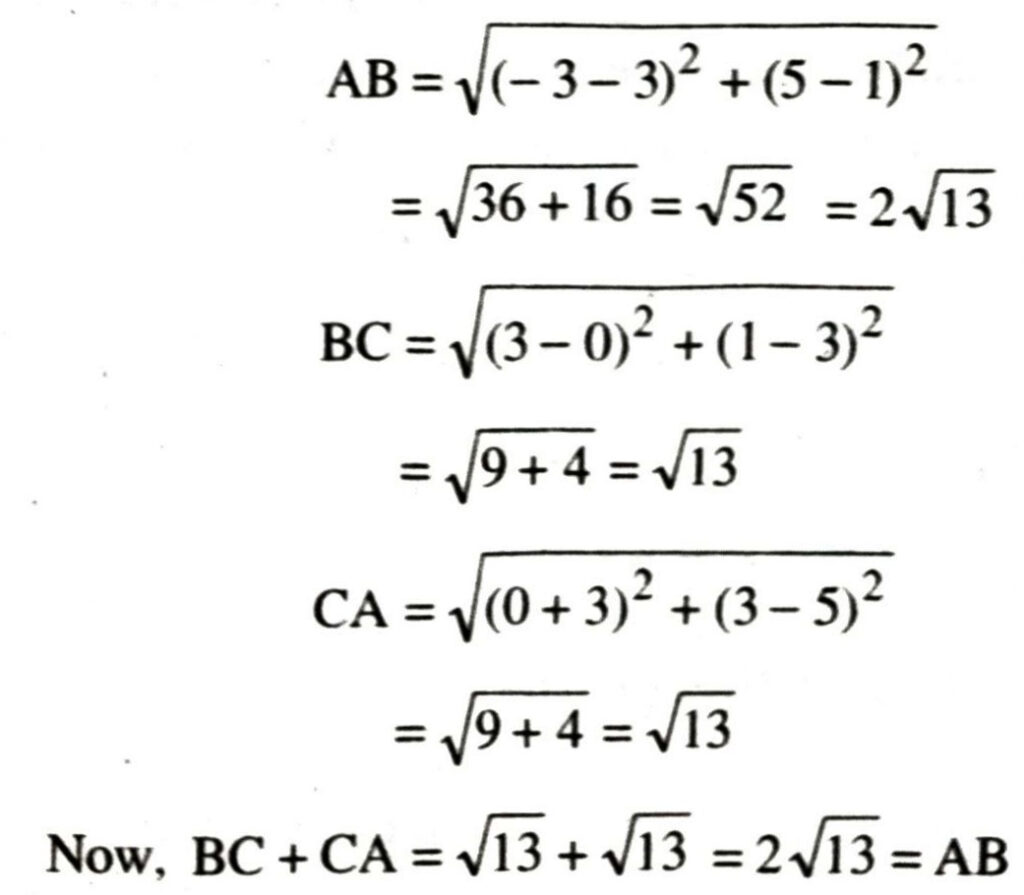
∴ A, B and C are collinear then A, B, C and D do not form any quadrilateral. Ans.
(iii) Given points are A (4, 5); B (7, 6); C (4, 3) and D (1, 2)
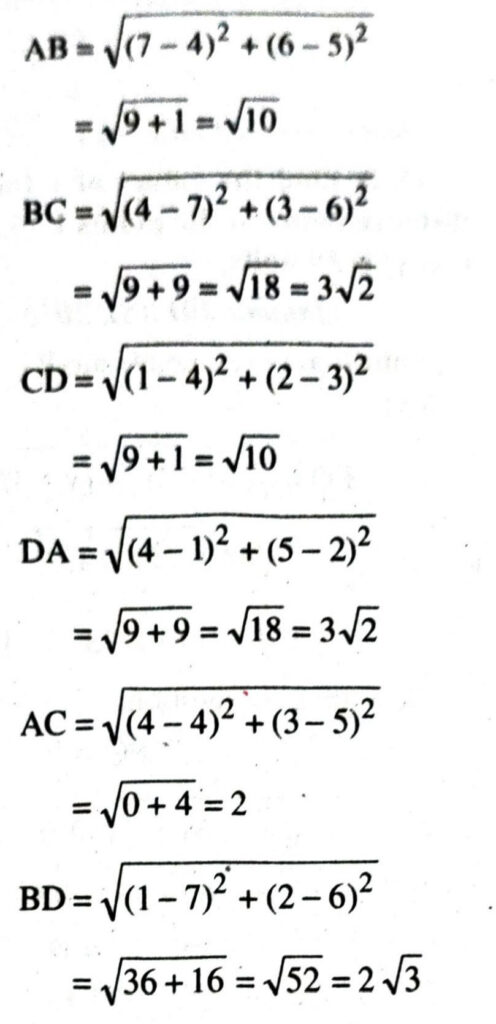
From above discussion, it is clear that
AB = CD and BC = DA and AC ≠ BD.
i.e., opposite sides are equal but their diagonals are not equal.
Hence, given quadrilateral ABCD is a parallelogram. Ans.
Q. 7. Find the points on the x-axis which is equidistant from (2,-5) and (-2, 9).
Solution. Let required point be P(x, 0)
and given points be A (2,-5) and B (-2,9).
According to question,
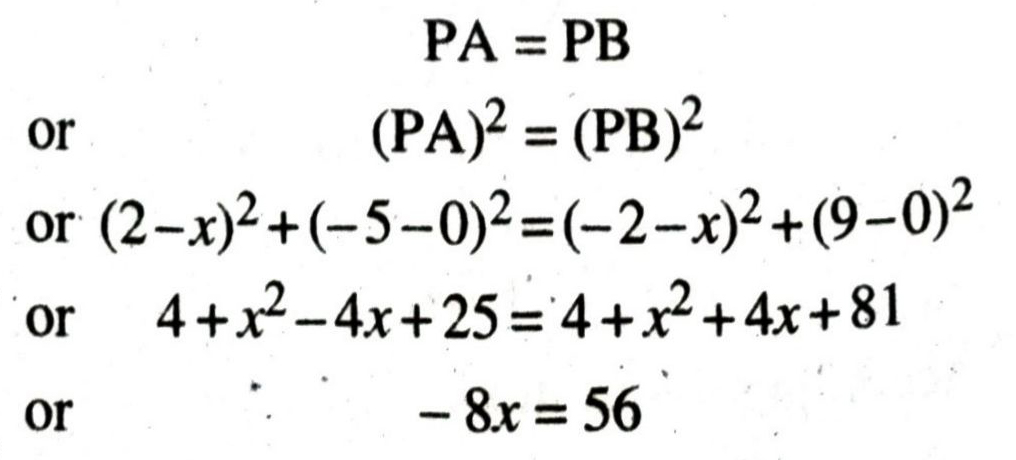

Hence, required point be (-7,0) Ans.
Q. 8. Find the values of y for which the distance between the points P (2, -3) and Q (10, y) is 10 units.
Solution. Given points are P (2, -3) and Q (10, y)
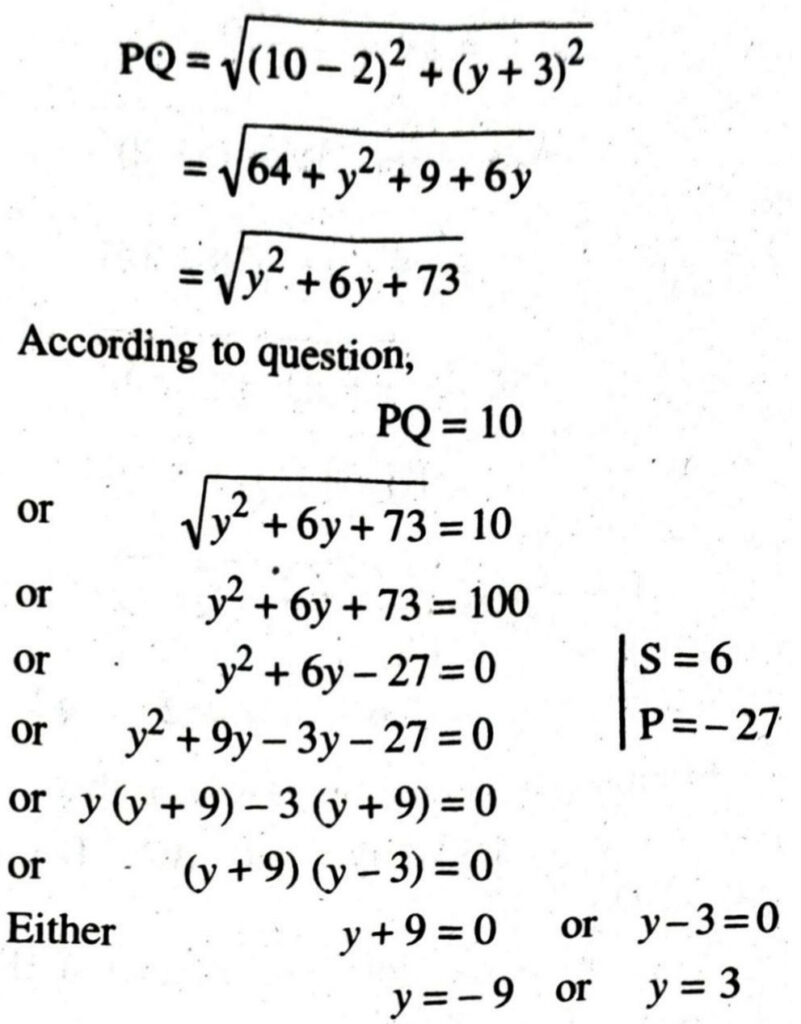
Hence, y = – 9 and 3 Ans.
Q. 9. If Q (0, 1) is equidistant from P (5,-3) and R (x, 6), find the values of x. Also find the distances QR and PR.
Solution. Given points Q (0, 1); P (5, -3) and R (x, 6)
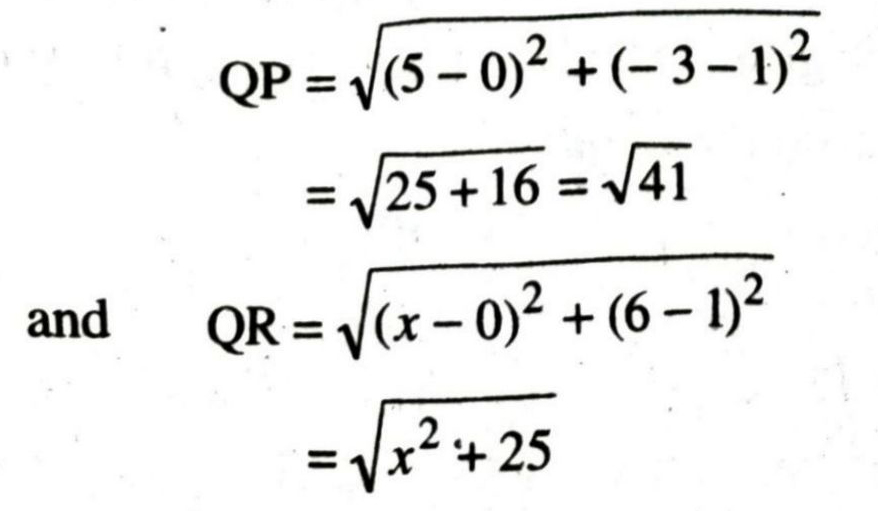
According to question,
QP = QR
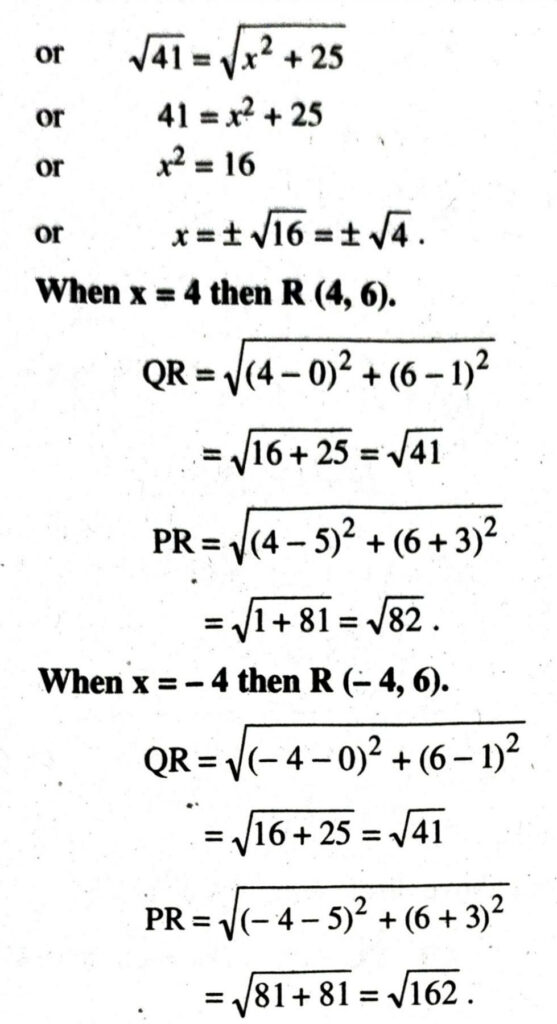
Q. 10. Find a relation between x and y such that the points (x, y) is equidistant from the point (3, 6) and (-3, 4).
Solution. Let required points be P (x, y) and given points are A (3, 6) and B (-3, 4)
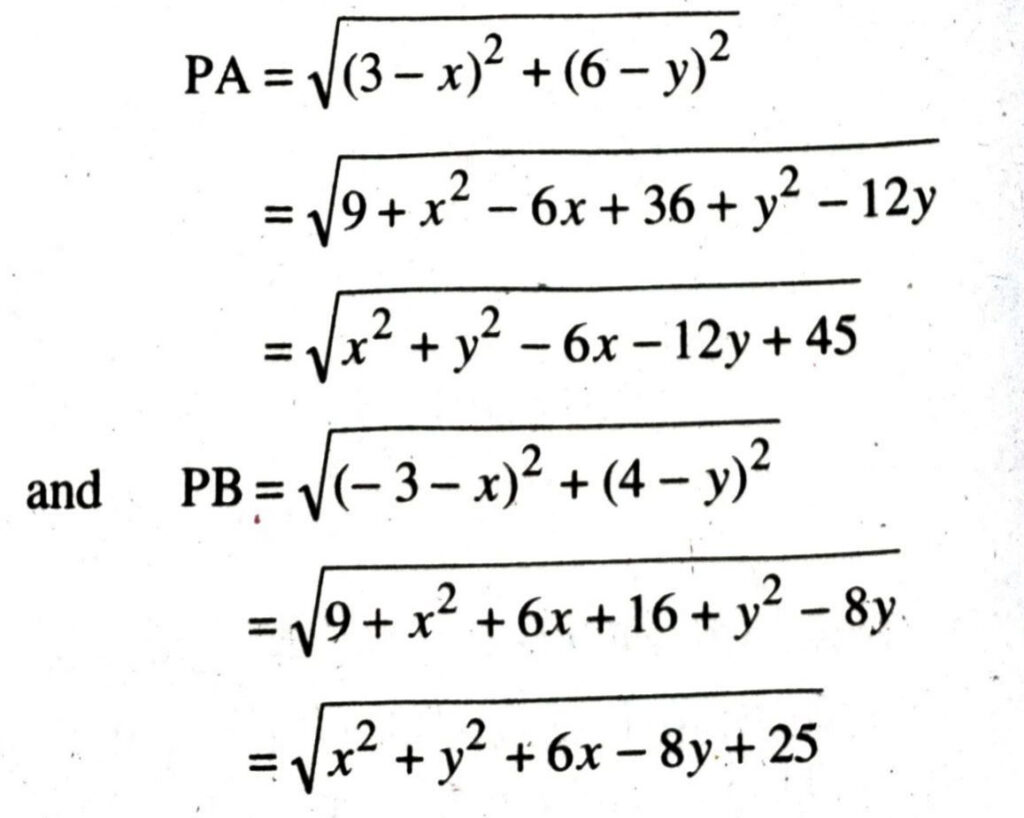
According to question,
PA = PB
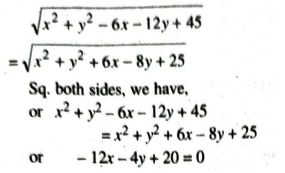
or 3x + y – 5 = 0 is the required relation. Ans.
TEXT BOOK EXERCISE 7.2
Q. 1. Find the co-ordinates of the point which divides the join of (- 1, 7) and (4, -3) in the ratio 2:3.
Solution. Let required point P (x, y) which divides the join of given points A (-1, 7) and B (4,3) in the ratio of 2 : 3.
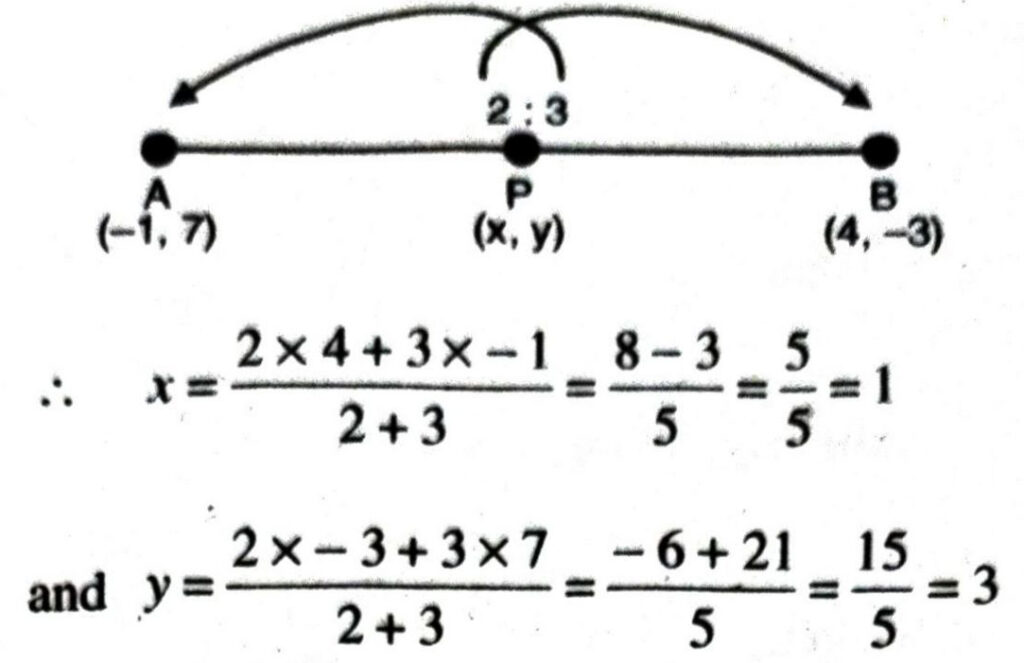
Hence, required point be (1, 3). Ans.
Q. 2. Find the co-ordinates of the points of trisection of the line segment joining (4, -1) and (-2,-3).
Solution. Let P (x1, y1) and Q (x2, y2) be the required points which trisected the line segment joining A (4, -1) and B (– 2, − 3) i.e., P (x1, y1) divides AB in ratio 1 : 2 and Q divides AB in ratio 2 : 1.
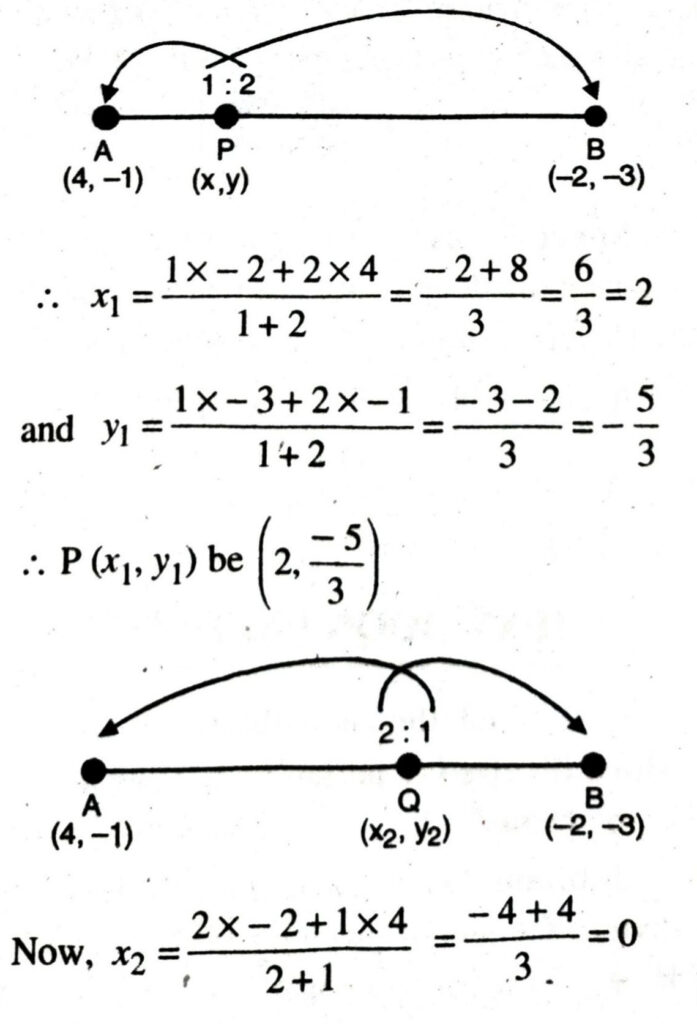
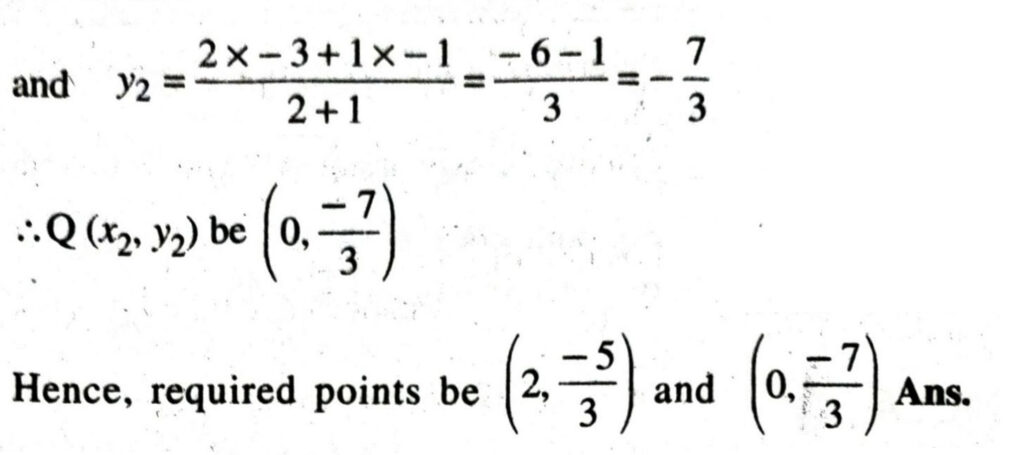
Q. 3. To conduct Sports Day activities, in your rectangular shaped school ground ABCD, lines have been drawn with chalk powder at a distance of 1m each. 100 flower pots have been placed at a distance of 1m from each other along AD, as shown in fig. Niharika runs ¼th the distance AD on the 2nd line and posts a green flag. Preet runs 1/5 th the distance AD on the eighth line and posts a green flag. What is the distance between both the flags? If Rashmi has to post a blue flag exactly half way between the line (segment) joining the two flags, where should she post her flag ?
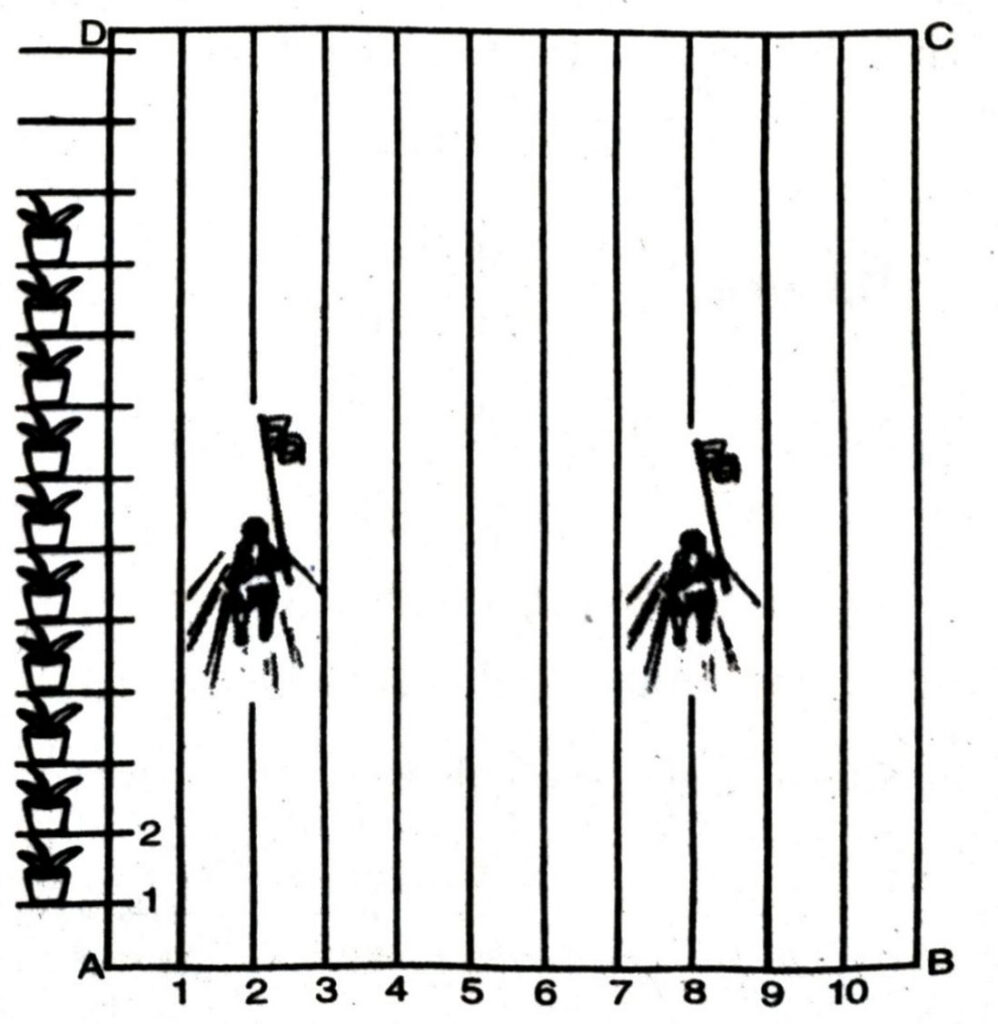
Solution. In the given figure, we take A as origin.
Taking x-axis along AB and y-axis along AD.
Position of green flag
= distance covered by Niharika
= Niharika runs ¼th distance AD on the 2nd line
= ¼ x 100 = 25 m
∴ Co-ordinates of the green flag are (2, 25) Now, position of red flag
= distance covered by Preet
= Preet runs 1/8 th the distance AD on the 8th line
= 1/5 x 100 = 20 m.
∴ distance between Green and Red flags
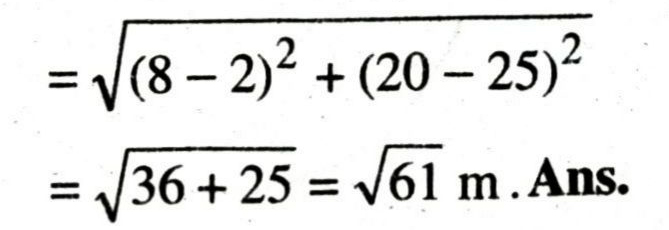
Position of blue flag
= mid point of green flag and red flag
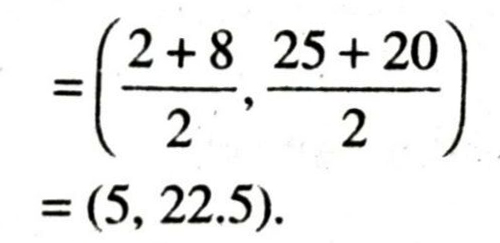
Hence, blue flag is in the 5th line and at a distance of 22.5 m along AD. Ans.
Q. 4. Find the ratio in which the segment joining the points (-3, 10) and (6,- 8) is divided by (-1, 6).
Solution. Let point P (- 1, 6) divides the line segment joining the points A (-3, 10) and B (6,- 8) in the ratio K:1

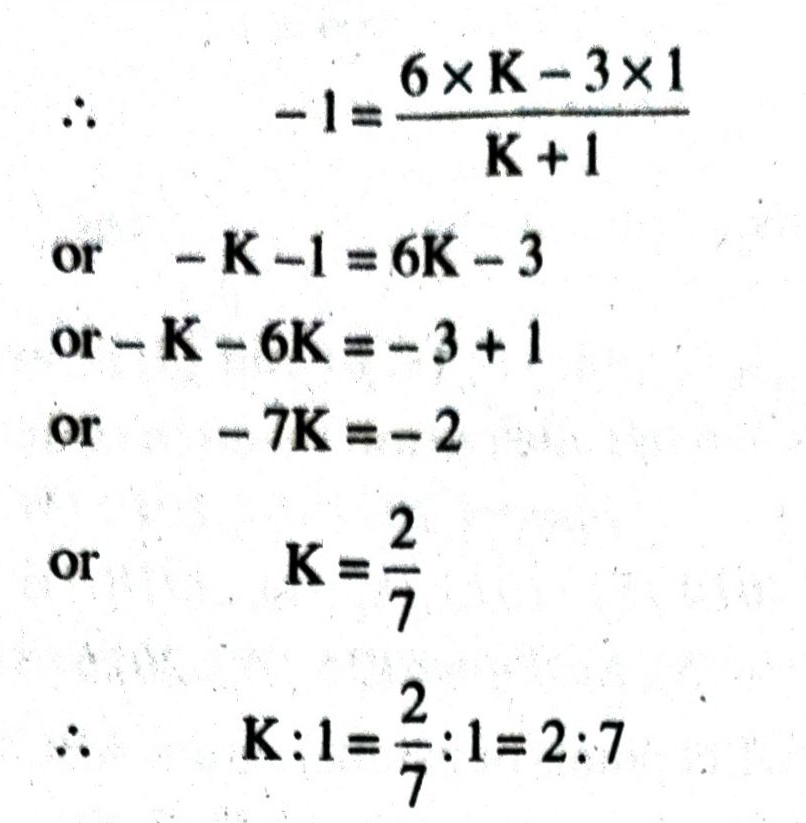
Hence, required ratio is 2: 7. Ans.
Q. 5. Find the ratio in which the line segment joining A (1,-5) and B (-4, 5) is divided by the x-axis. Also find the coordinates of the point of division.
Solution. Let required point on x-axis is P (x, 0) which divides the line segment joining the points A (1,- 5) and B (- 4, 5) in the ratio K: 1.
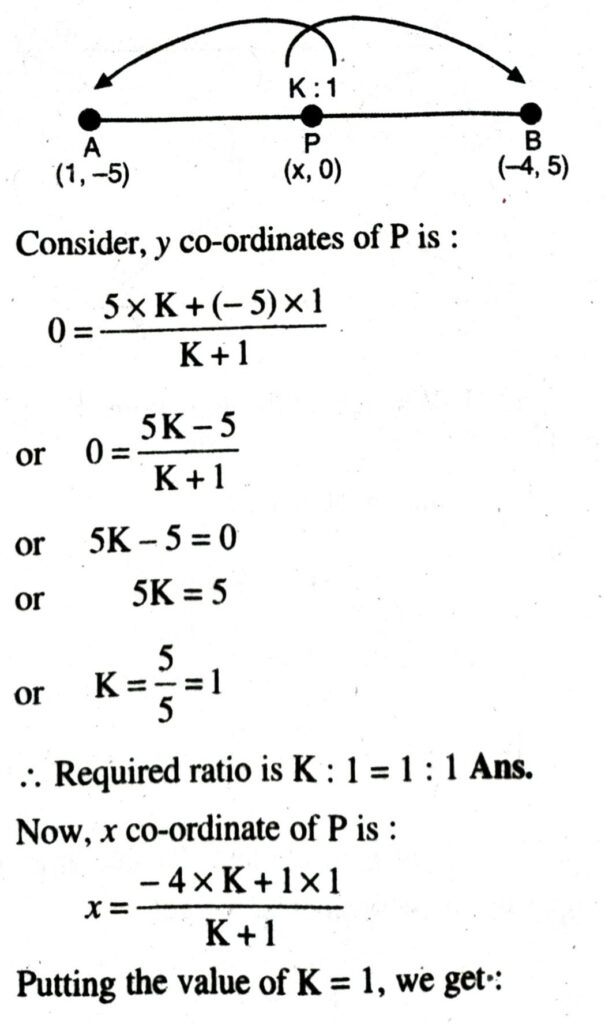

Q. 6. If (1, 2); (4, y); (x, 6) and (3, 5) are the vertices of a parallelogram taken in order, find x and y.
Solution. Let points of parallelogram ABCD are A (1, 2); B (4, y) ; C (x, 6) and D (3, 5)
But diagonals of a || gm bisect each other.
Case I. When E is the mid point of A (1, 2) and C (x, 6)
∴ Co-ordinates of E are:
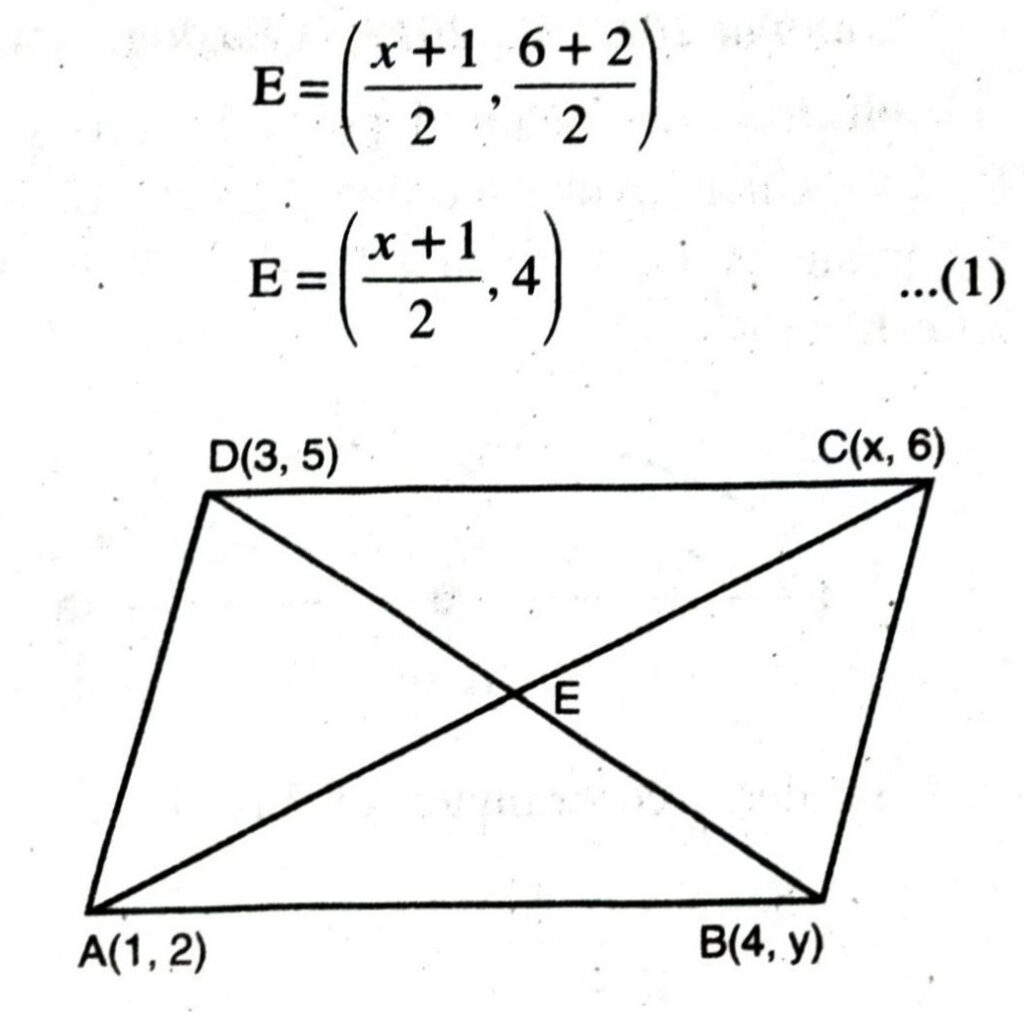
Case II. When E is the mid point B (4, y) and D (3, 5)
∴ Co-ordinates of E are:
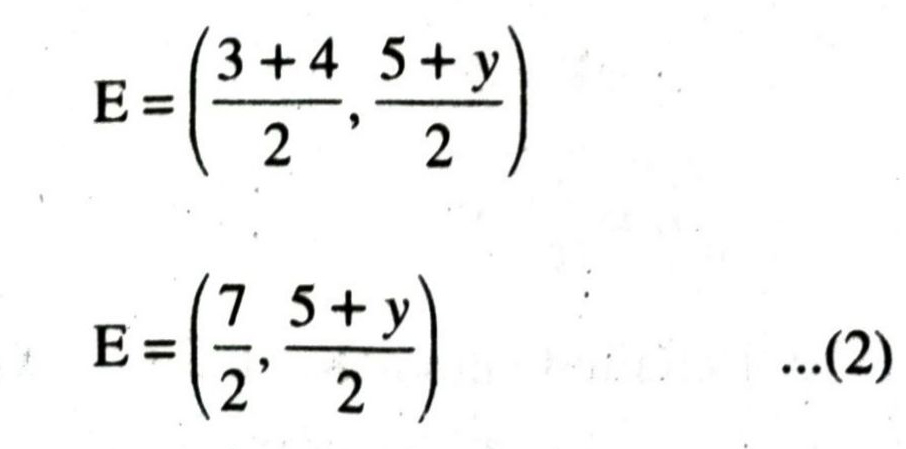
But values of E in (1) and (2) are same, so comparing the coordinates, we get
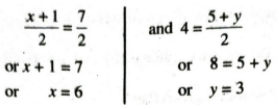
Hence, values of x and y are 6 and 3. Ans.
Q. 7. Find the co-ordinates of a point A, where AB is the diameter of a circle whose centre is (2,-3) and B is (1,4).
Solution. Let, co-ordinates of A be (x, y) But, centre is the mid point of the vertices of the diameter.
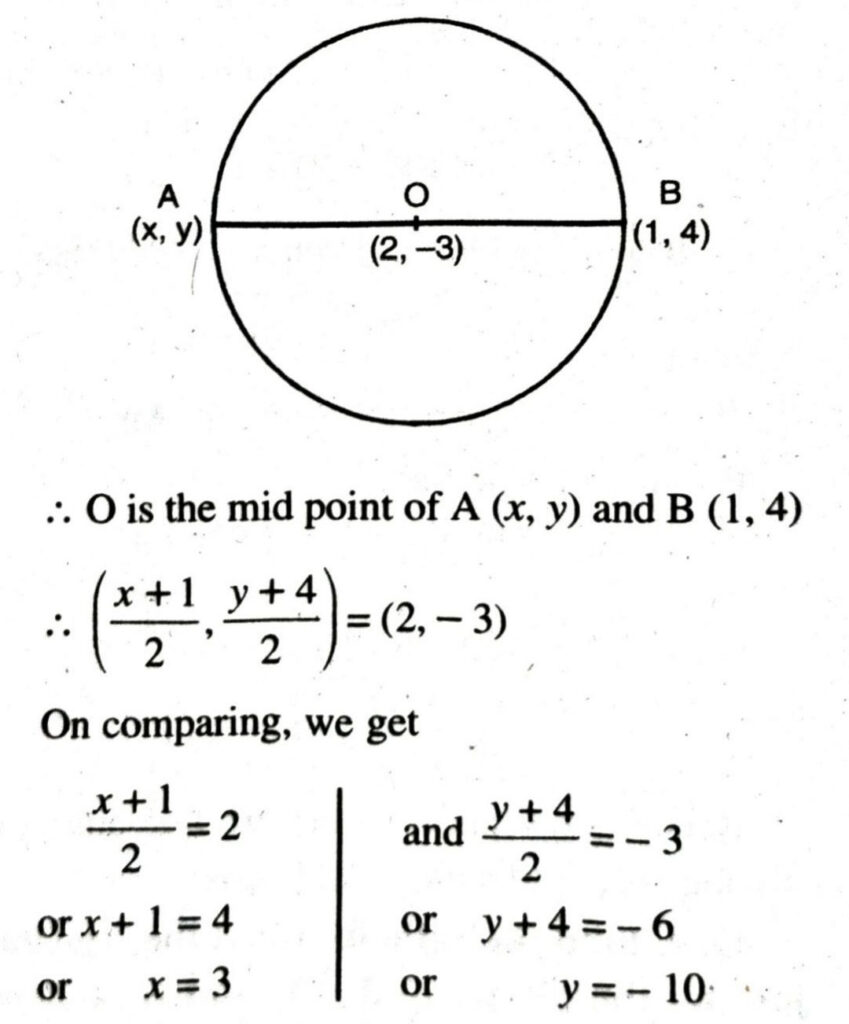
Hence, required point A be (3, 10) Ans.
Q. 8. If A and B are (-2,-2) and (2,-4) respectively, find the co-ordinates of P such that AP= 3/7 AB and P lies in the line segment AB.
Solution. Let required point P be (x, y)
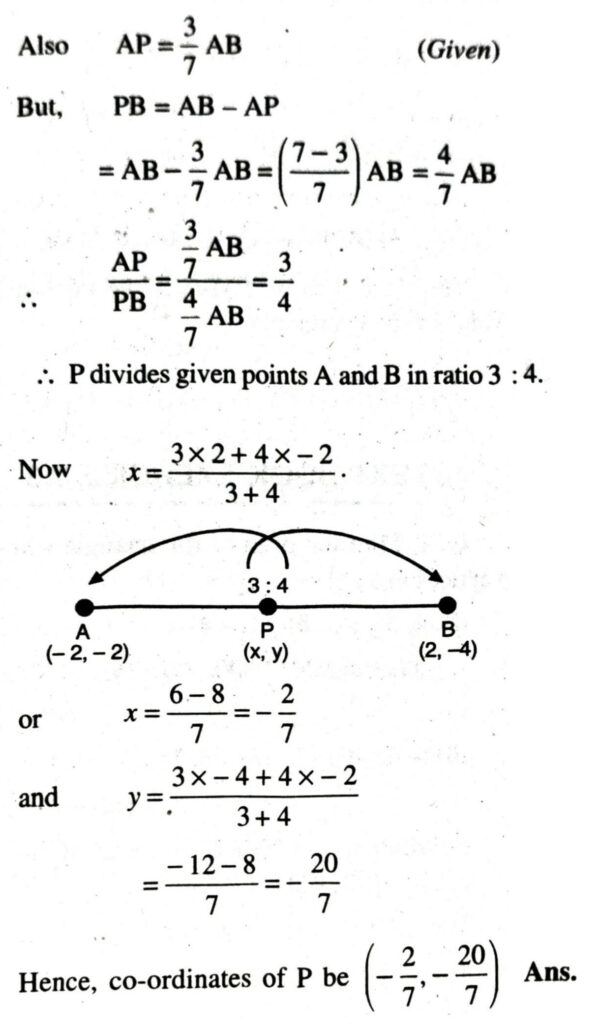
Q. 9. Find the coordinates of the points which divides the line segment joining A (-2, 2) and B (2, 8) into four equal parts.
Solution. Let required points are C, D and E which divide the line segment joining the points A (-2, 2) and B (2, 8) into four equal parts.
Then D is mid point of A and B ; C is the mid point of A and D; E is the mid point of D and B such that
AC = CD= DE = EB
Now, mid point of A and B
(i.e., Coordinates of D)
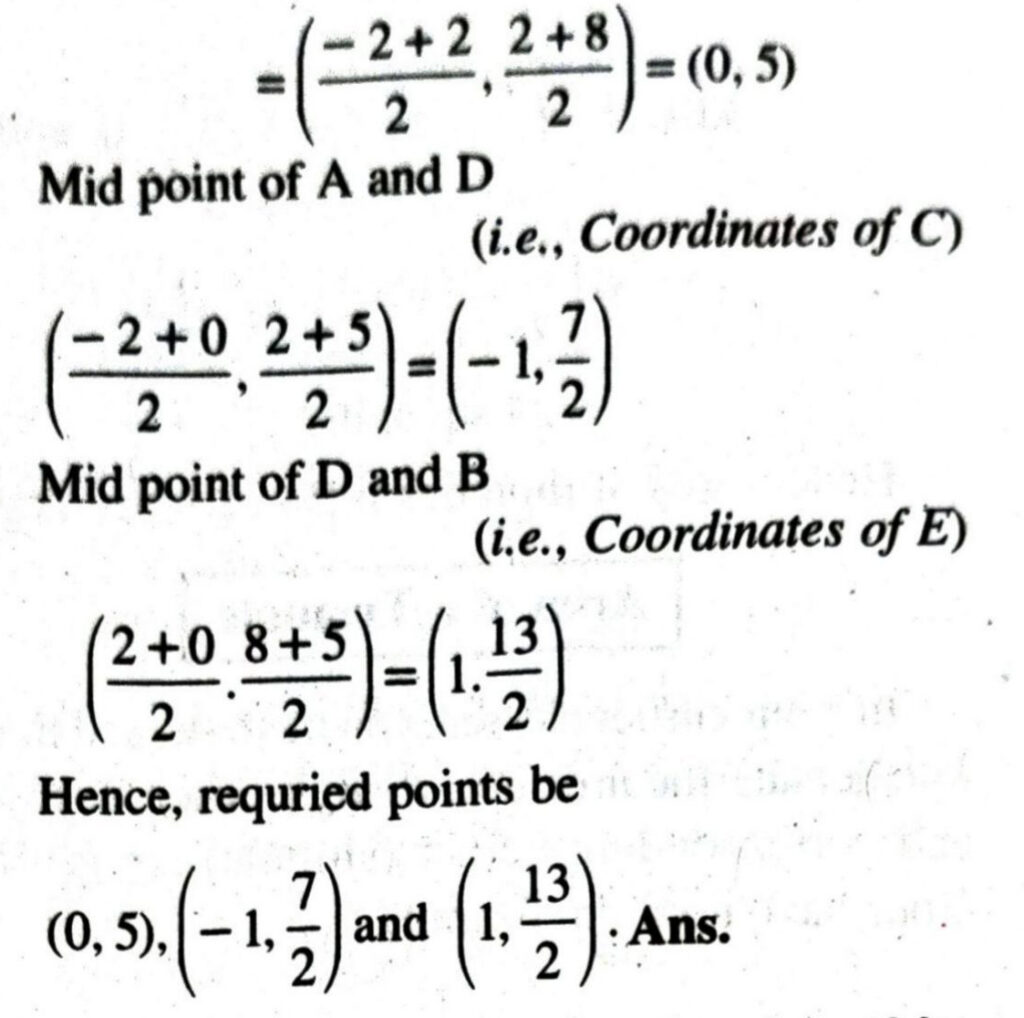
Q. 10. Find the area of a rhombus if its vertices are (3, 0); (4, 5); (− 1, 4) and (-2, − 1) taken in order.
[Hint: Areas of a rhombus = 1/2 (Product of its diagonals)]
Solution. Let co-ordinates of rhombus ABCD are A (3, 0); B (4, 5); C (-1, 4) and D (-2-1).
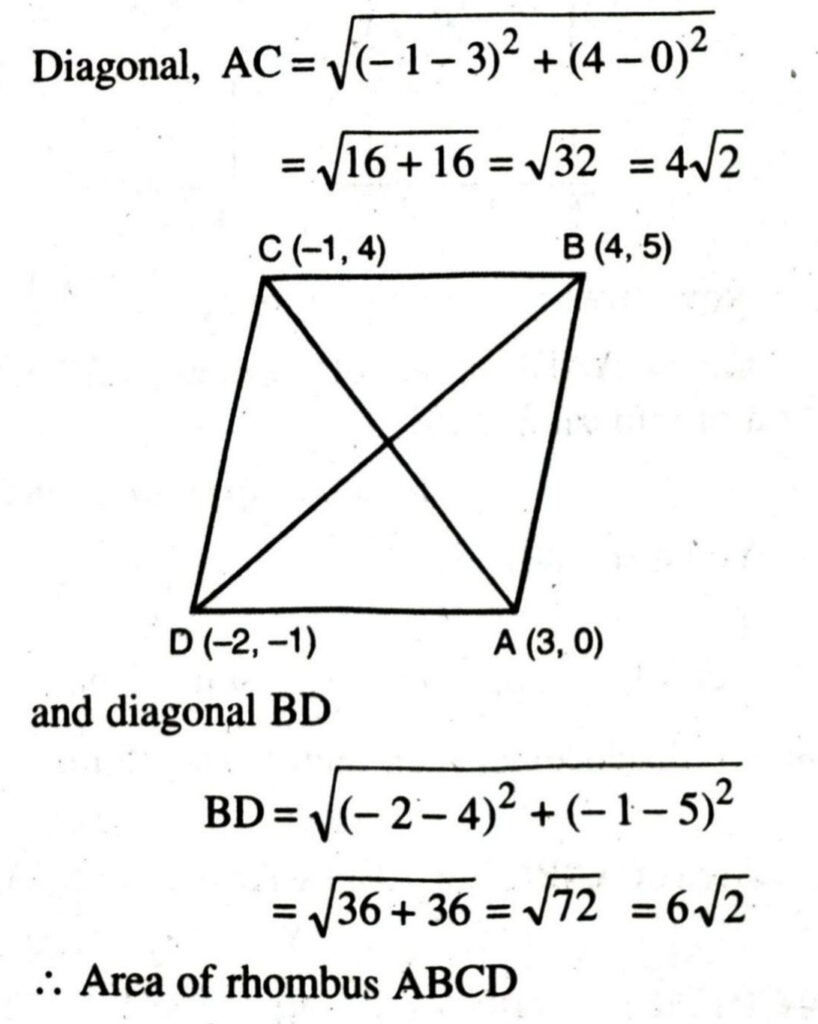
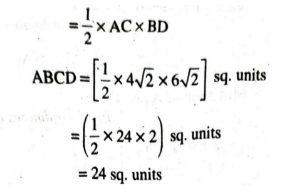
Hence, area of rhombus is 24 sq. units. Ans.
TEXT BOOK EXERCISE 7.3
Q. 1. Find the area of the triangle whose vertices are:
(i) (2, 3); (-1, 0); (2, – 4)
(ii) (-5, -1); (3,-5); (5,2)
Solution. (i) Let vertices of the AABC are A (2, 3); B (-1, 0) and C (2,-4)
Here x1 = 2, x2 = -1, x3 = 2
y1 = 3, y2 = 0, y3 = -4

(ii) Let vertices of the AABC are A (-5, -1); B (3,-5) and C (5,2)
Here x1 = -5, x2 = 3, x3 = 5
y1 =-1, y2 = -5, y3 = 2
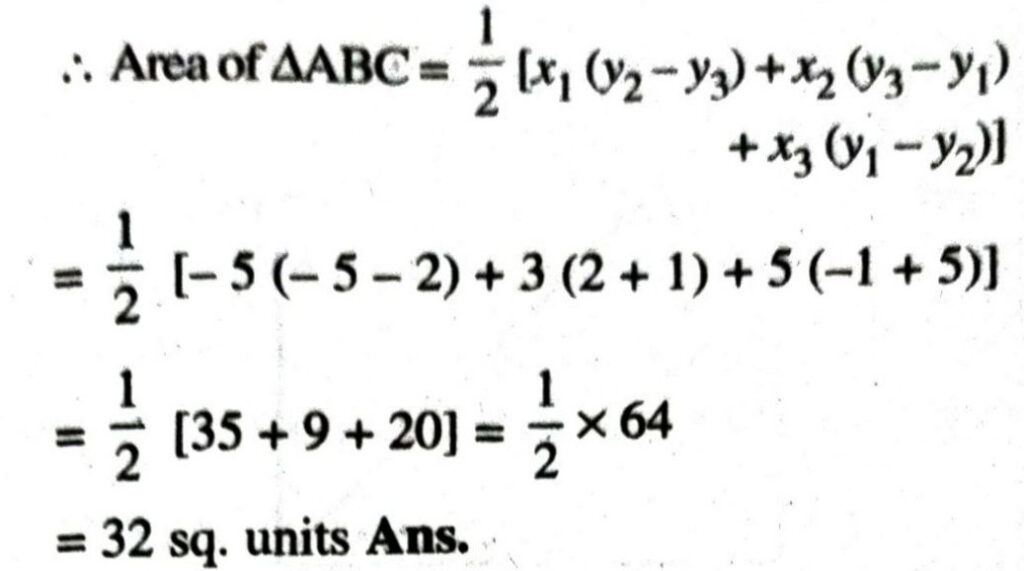
Q. 2. In each of the following find the value of ‘k’ for which the points are collinear.
(i) (7,-2); (5, 1); (3, k)
(ii) (8, 1); (k, – 4); (2,-5)
Solution.
(i) Let given points be A (7, – 2); B (5, 1) and C (3, k)
Here x1 = 7, x2 = 5, x3 = 3
y1 = -2, y2 = 1, y3 = k
Three points are collinear iff
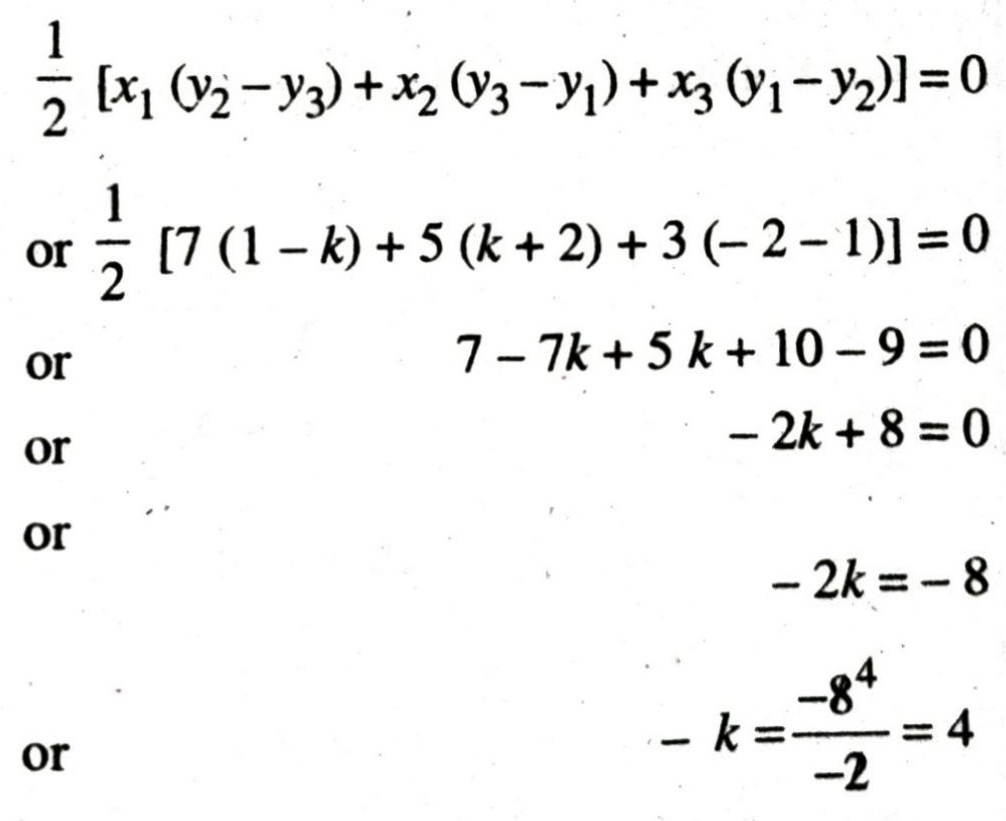
Hence k = 4 Ans.
(ii) Let given points be A (8, 1); B (k, – 4) and C (2,-5)
Here x1 = 8, x2 = k, x3 = 2
y1 = 1, y2 = 4, y3 = -5
Three points are collinear iff
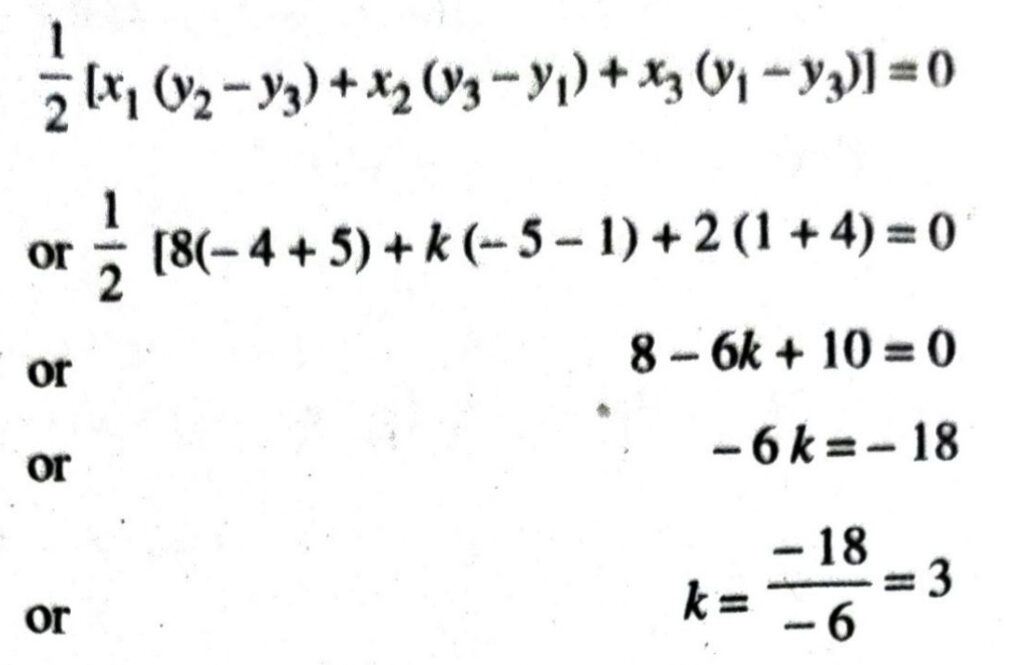
Hence k = 3 Ans.
Q. 3. Find the area of the triangle formed by joining the midpoints of the sides of the triangle whose vertices are (0, -1), (2, 1) and (0, 3). Find the ratio of the area of the triangle formed to the area of the given triangle.
Solution.
Let vertices of given triangle ABC are A(0, 1); B (2, 1) and C (0, 3).
Also, D, E, F be the mid points of AB, BC, CA respectively.
Using mid point formula,
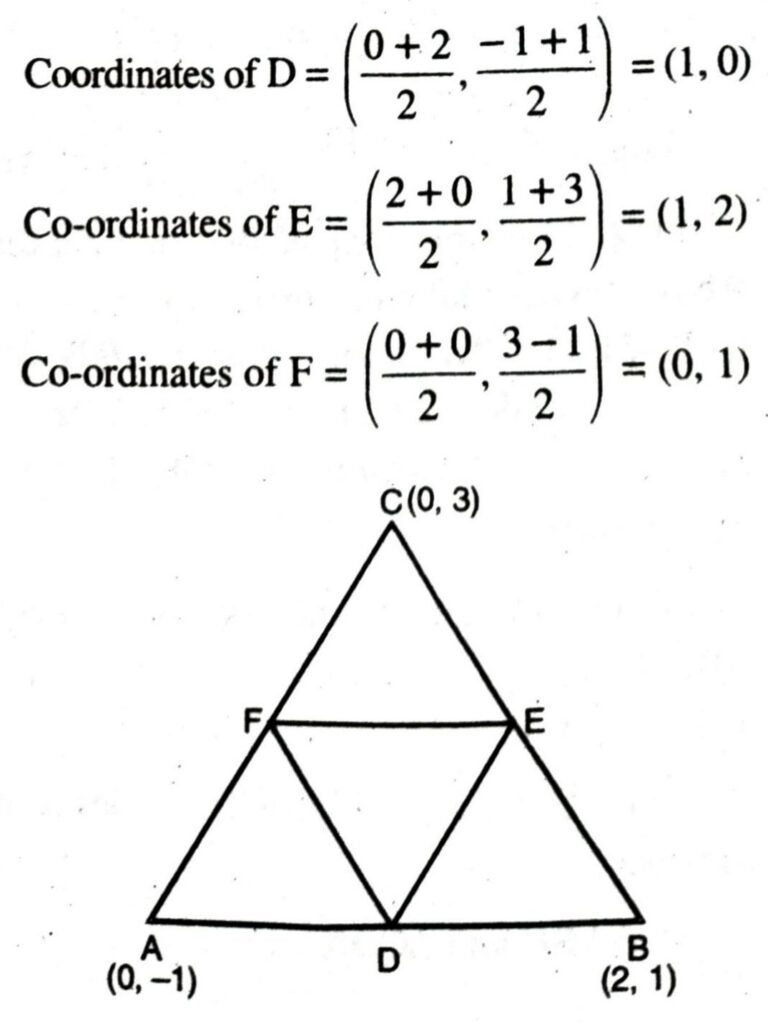
∴ Co-ordinates of the vertices of ΔDEF are D (1, 0); E (1, 2); F (0,1).
Here x1 = 1, x2 = 1, x3 = 0
y1 = 0, y2 = 2, y3 = 1
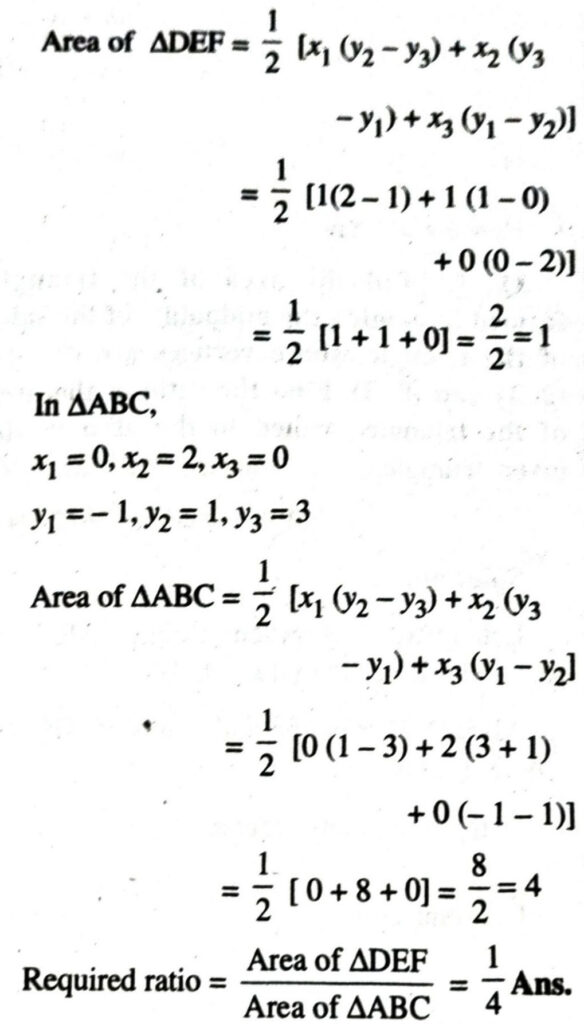
Q. 4. Find the area of the quadrilateral whose vertices taken in order, are (-4, – 2); (-3,-5); (3,-2); (2, 3).
Solution.
Let co-ordinates of the given quadrilateral ABCD are A (-4,-2); B (-3,-5); C (3,-2) and D (2, 3).
Join AC then Quad. ABCD divides in two triangles
ie. ΔABC and ACDA
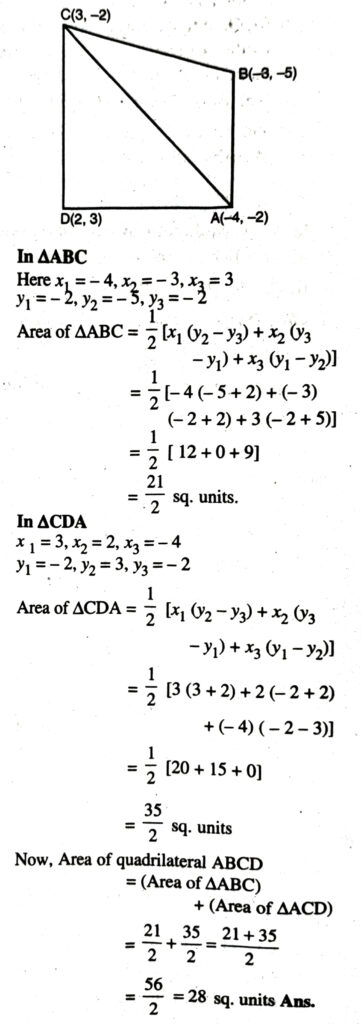
Q. 5. You have studied in Class IX, (Chapter 9, Q. 3) that a median of a triangle divides it into two triangles of equal areas. Verify this result for AABC whose vertices are A(4,-6), B(3,-2) and C(5,2).
Solution. Given that co-ordinates of the vertices of AABC are A(4,-6); B (3,-2) and C (5,2).
Let CD is the median i.e. D is the mid point of AB which divides AABC into two parts i.e.
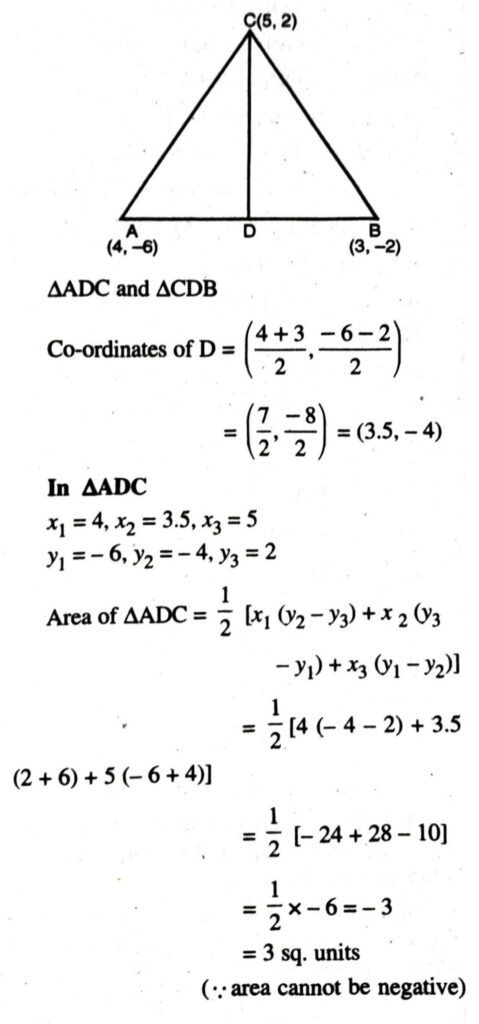

From above discussion it is clear that area of ΔADC = area of ΔCDB = 3 sq. units.
Hence, a median of a triangle divides it into two triangles of equal areas.
TEXT-BOOK EXERCISE 7.4
(OPTIONAL)
Q. 1. Determine the ratio in which the line 2x+y-4-0 divides the line segment joining the points A (2,-2) and B (3, 7).
Solution.
Let line 2x + y -4 = 0 divides the line segment joining the points A (2,-2) and B(3, 7) at C (x, y) in the ratio k: 1
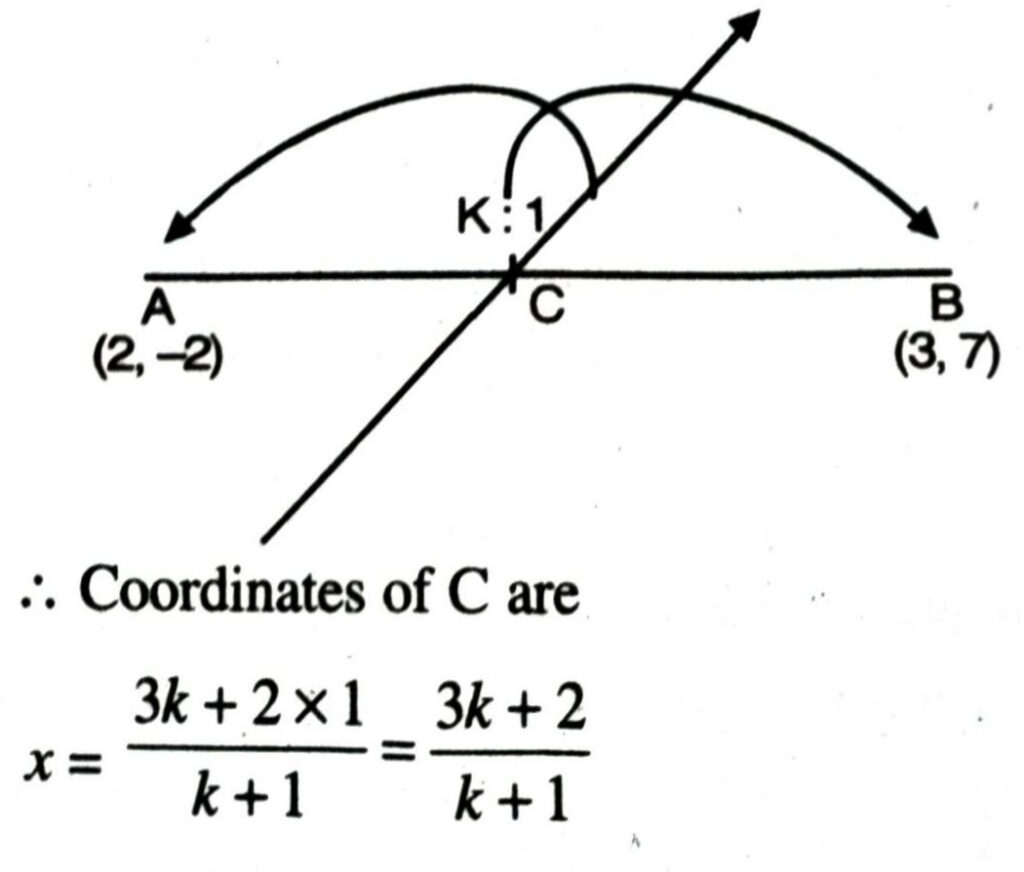
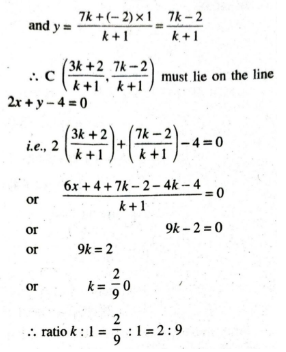
Hence required ratio is 2 : 9 Ans.
Q. 2. Find a relation between x and y if (x, y); (1, 2) and (7,0) are collinear.
Solution. Let given points are A (x, y); B (1, 2) and C (7,0).
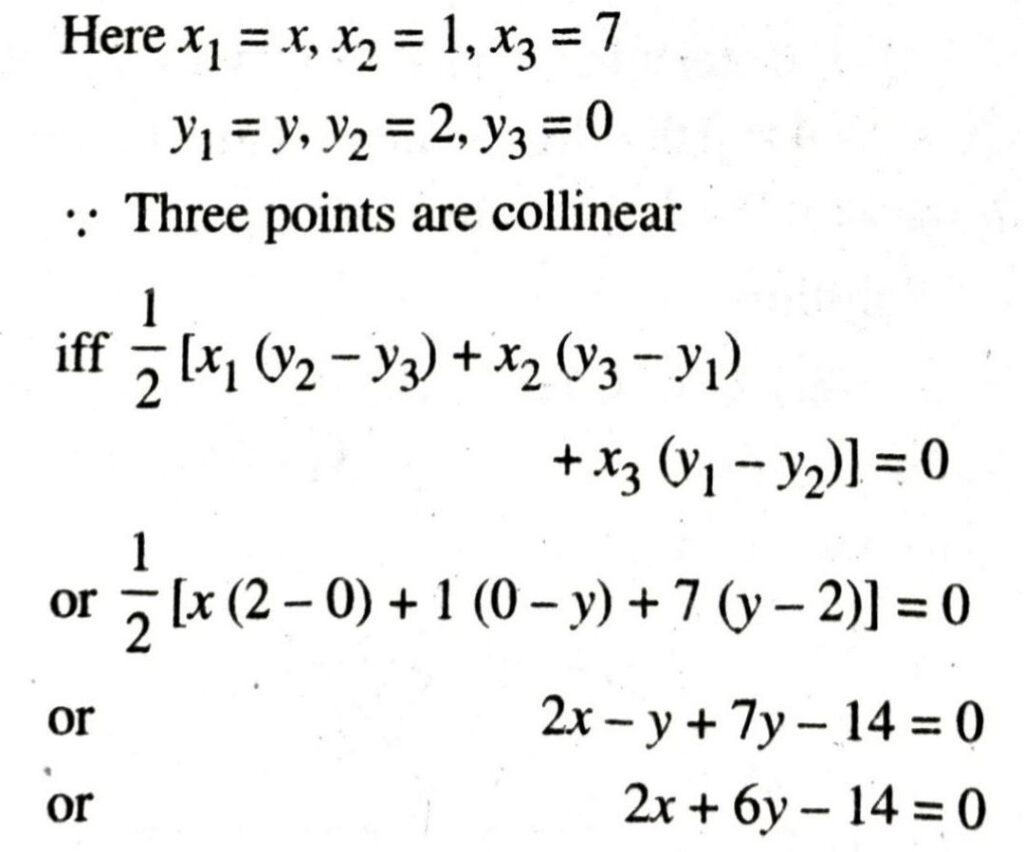
or x + 3y – 7 = 0 is the required relation. Ans.
Q. 3. Find the centre of a circle passing through the points (6, – 6); (3, – 7) and (3, 3).
Solution. Let O (x, y) be the required centre of the circle which passes through points P (6, 6); Q (3, -7) and R (3, 3).
∴ radii of circle are equal.
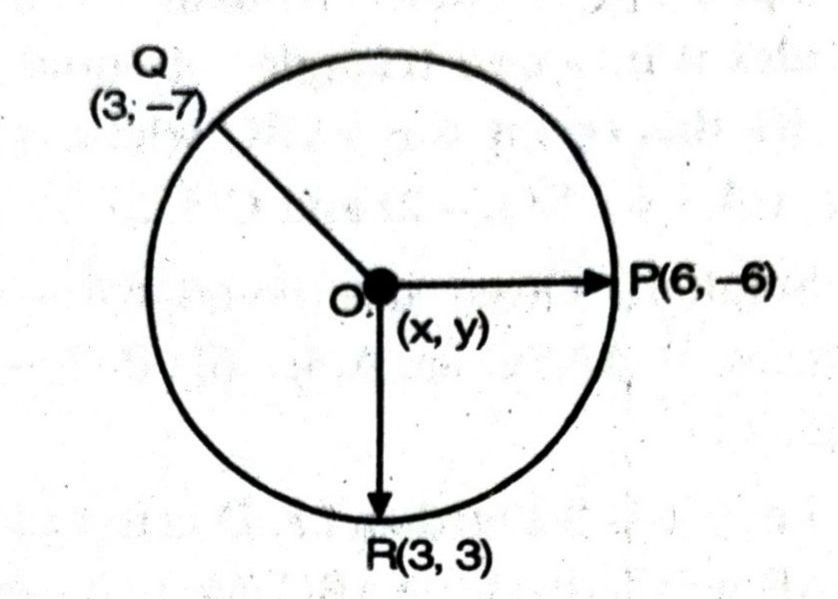
∴ OP = OQ = OR
or (OP)² = (OQ)² = (OR)²
Now, (OP)² = (0Q)²
(x-6)² + (y + 6)² = (x-3)² + (y+7)²
or x² + 36 – 12x + y² + 36 + 12y
= x² + 9 – 6x + y² + 49 + 14y
or – 12x + 12y + 72 = − 6x + 14y + 58
or – 6x – 2y + 14 = 0
or 3x + y – 7 = 0 …(1)
Also, (OQ)² = (OR)²
or (x-3)² + (y + 7)² = (x-3)² + (y – 3)²
or (y+7)² = (y – 3)²
or y² + 49 + 14y = y² + 9 – 6y
or 20y = – 40
Substitute this value of y in (1), we get
3x – 2 – 7 = 0
or 3x – 9 = 0
or 3x = 9

∴ Required centre is (3,-2) Ans.
Q. 4. The two opposite vertices of a square are (-1, 2) and (3, 2). Find the coordinates of other two vertices.
Solution. Let two opposite vertices of a square ACBD are A (-1, 2) and B (3, 2) and coordinates of Care (x, y)
∵ Length of each sides of square are equal.
∴ AC = BC
or (AC)² = (BC)²
or (x + 1)² + (y-2)² = (x-3)² + (y-2)²
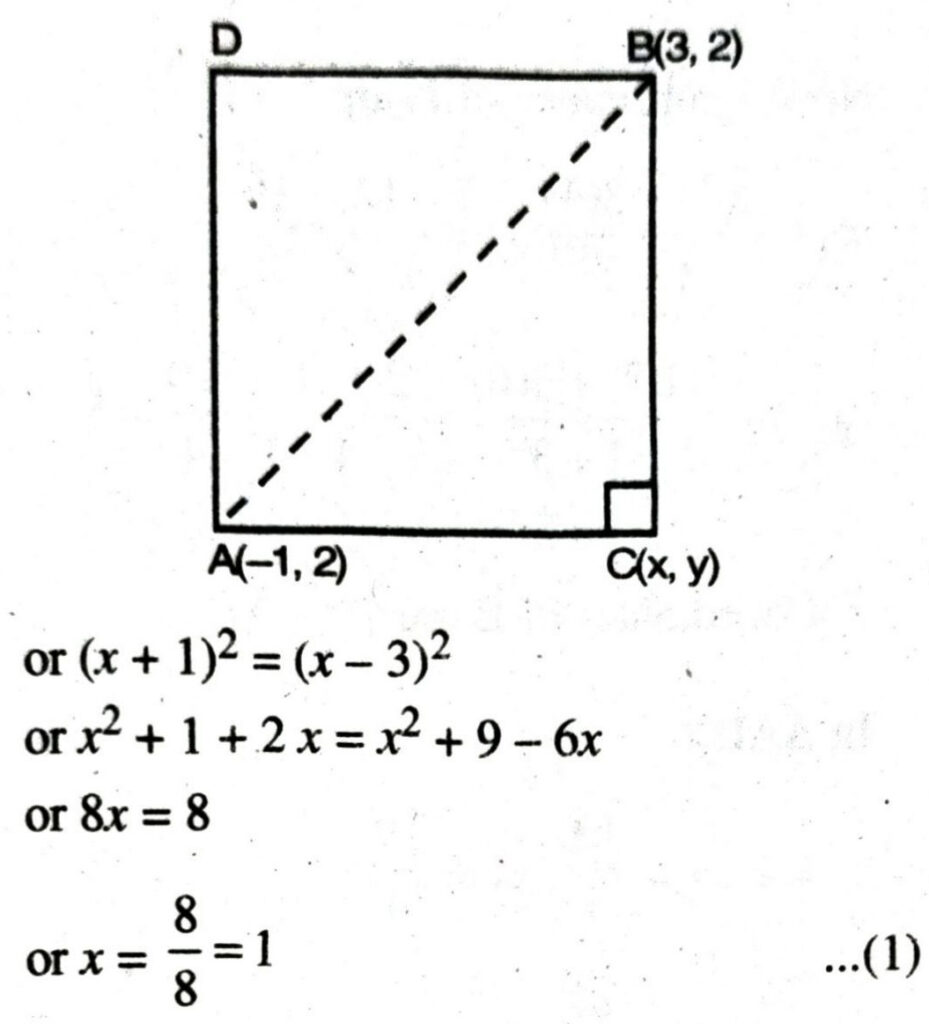
Now, in rt ∠d ΔACB,
Using Pythagoras Theorem,
(AC)² + (BC)² = (AC)²
(x + 1)² + (y-2)² + (x − 3)² + (y-2)² = (3+1)² + (2-2)²
or x² + 1 + 2x + y² + 4 – 4y + x² + 9 – 6x + y² + 4 – 4y = 16
or 2x² + 2y² – 4x – 8y + 2 = 0
or x² + y² – 2x – 4y + 1 = 0
Putting the value of x = 1 from (1), we get
(1)² + y² – 2 (1) – 4y + 1 = 0
or y² – 4y = 0
or y (y – 4) = 0
Either y = 0 or y – 4 = 0
Either y = 0 or y = 4
∴ y = 0, 4
∴ Required points are (1, 0) and (4, 0). Ans.
Q. 5. The Class X students of a secondary school in Krishinagar have been allotted a rectangular plot of land for their gardening activity. Sapling of Gulmohar are planted on the boundary at a distance of 1m from each other. There is a triangular grassy lawn in the plot as shown in the Fig. The students are to sow seeds of flowering plants on the remaining area of the plot.
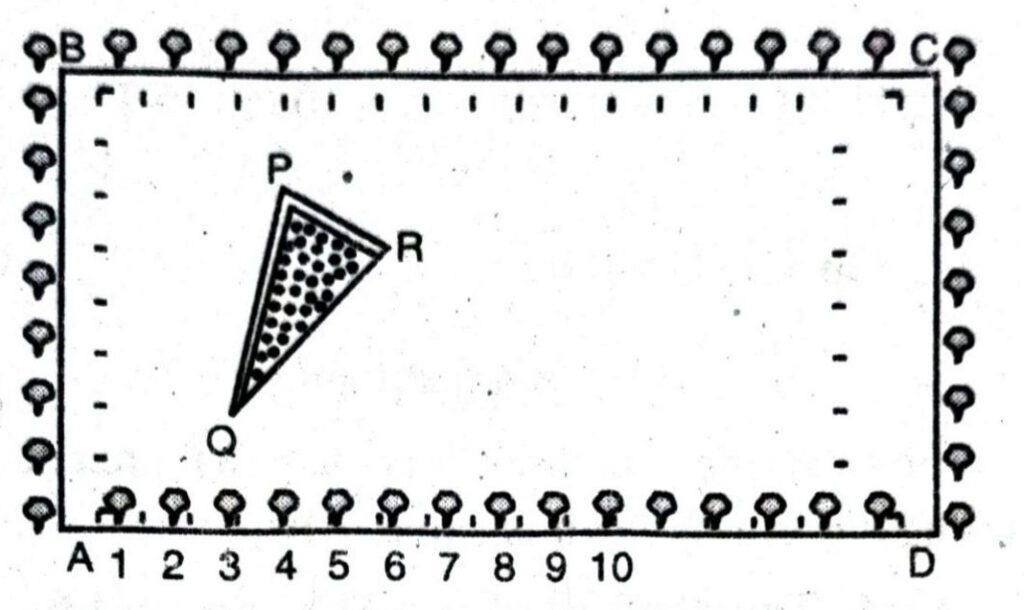
(i) Taking A as origin, find the coordinates of the vertices of the triangle.
(ii) What will be the coordinates of the vertices of Δ PQR if C is the origin? Also calculate the arc of the triangle in this cases. What do you observe ?
Solution.
Case I.
When taking A as origin then AD is X-axis and AB is Y-axis.
∴ Coordinates of triangular grassy Lawn PQR are P (4, 6); Q (3, 2) and R( 6, 5).
Here x1 = 4, x2 = 3, x3 = 6
y1 = 6, y2 = 2, y3 = 5
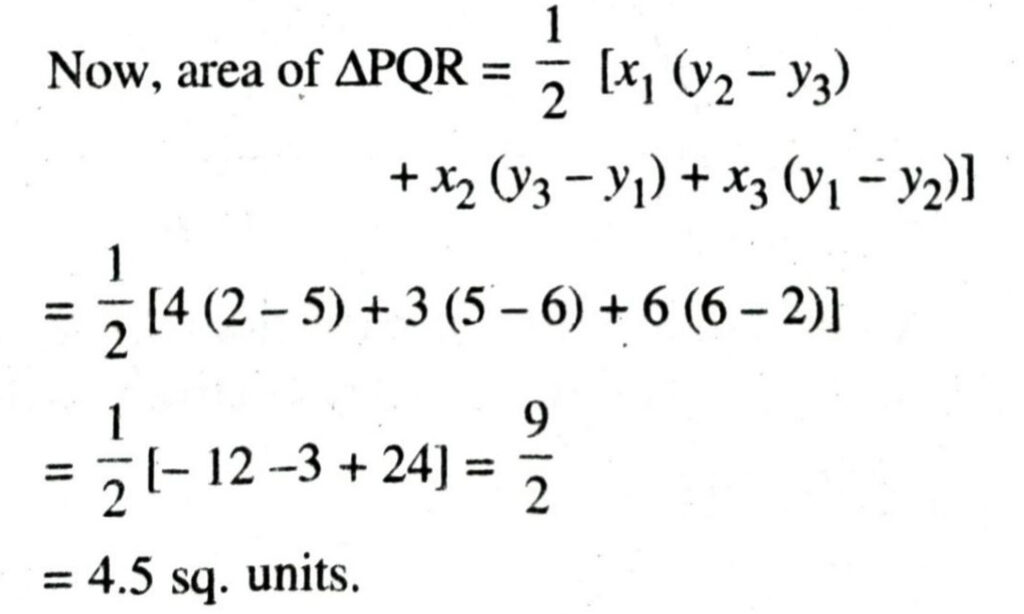
Case II.
When taking C as origin then CB is X-axis and CD is Y-axis.
∴ Coordinates of triangular grassy lawn PQR are P (12, 2); Q (13, 6) and R (10, 3)
Here x1 = 12, x2 = 13, x3 = 10
y1 = 2, y2 = 6, y3 = 3
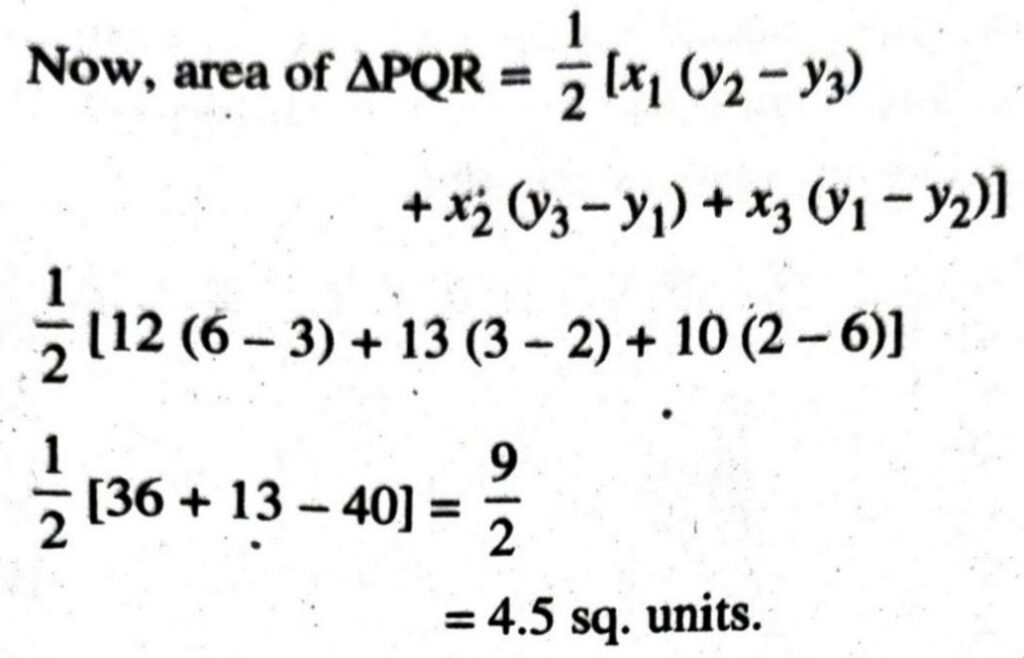
From above two cases, it is clear that area of triangular grassy lawn is same. Ans.
Q. 6. The vertices of a ΔABC are A(4,6), B(1,5) and C(7, 2). A line is drawn to intersect sides AB and AC at D and E respectively, such that  Calculate the area of the ΔADE and compare it with the area of ΔABC. (Recall Theorem 6.2 and Theorem 6.6).
Calculate the area of the ΔADE and compare it with the area of ΔABC. (Recall Theorem 6.2 and Theorem 6.6).
Solution. The vertices of ΔABC are
A (4, 6); B (1, 5) and C (7, 2)
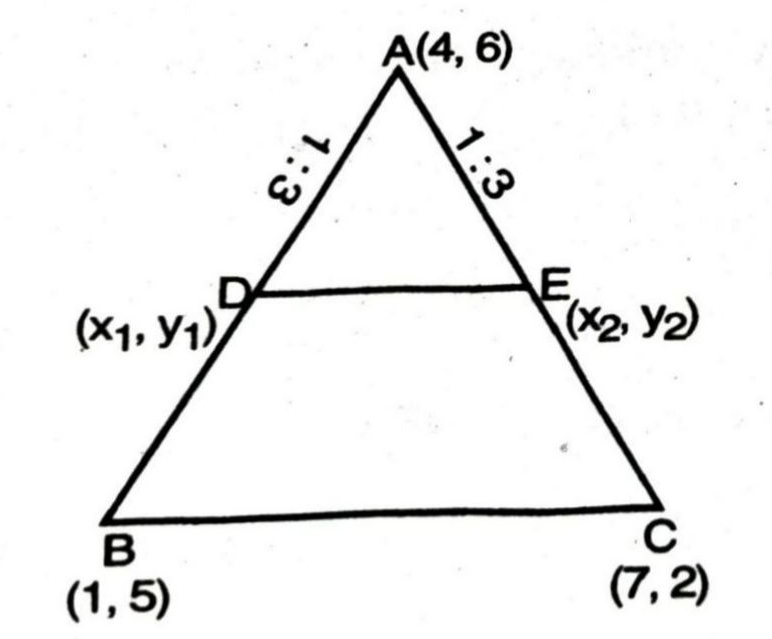
A line is drawn to intersect sides AB and AC at D (x1, y1) and E (x2, y2) respectively such that 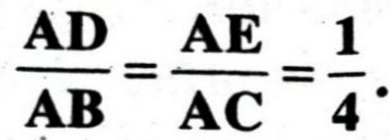
∴ D and E divides AB and AC in the ratio 1:3
∴ Coordinates of D are

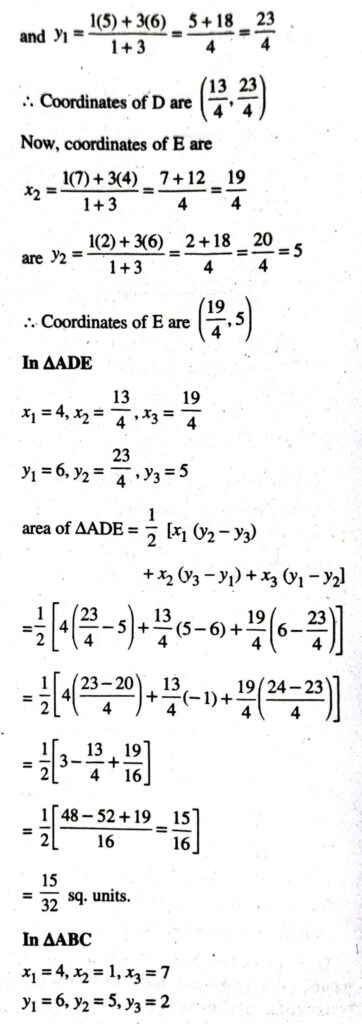
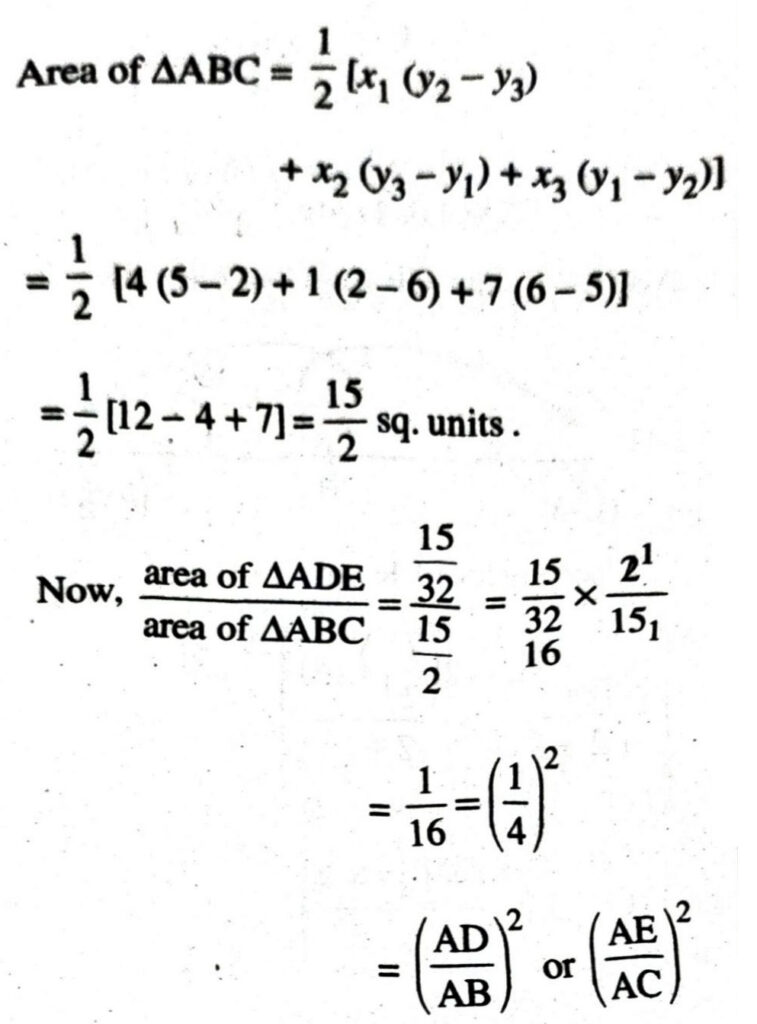
Q. 7. Let (4, 2), B (6, 5) and C (1, 4) be the vertices of ΔABC.
(i) The median from A meets BC at D. Find the coordinates of the point D.
(ii) Find the coordinates of the point P on AD such that AP: PD = 2:1
(iii) Find the coordinates of points Q and R on medians BE and CF respectively such that BQ: QE = 2:1 and CR : RF = 2:1.
(iv) What do you observe ?
[Note: The point which is common to all the three medians is called centroid and this point divides each median in the ratio 2 : 1]
(v) If A(x₁, y₁), B(x2, y2) and C (x3, y3) are the vertices of ΔABC, find the coordinates of the controid of the triangle.
Solution. Given that vertices of ΔABC are A (4, 2); B (6, 5) and C (1, 4).
(i) AD is the median from the vertex A.
∴ D is the mid point of BC.
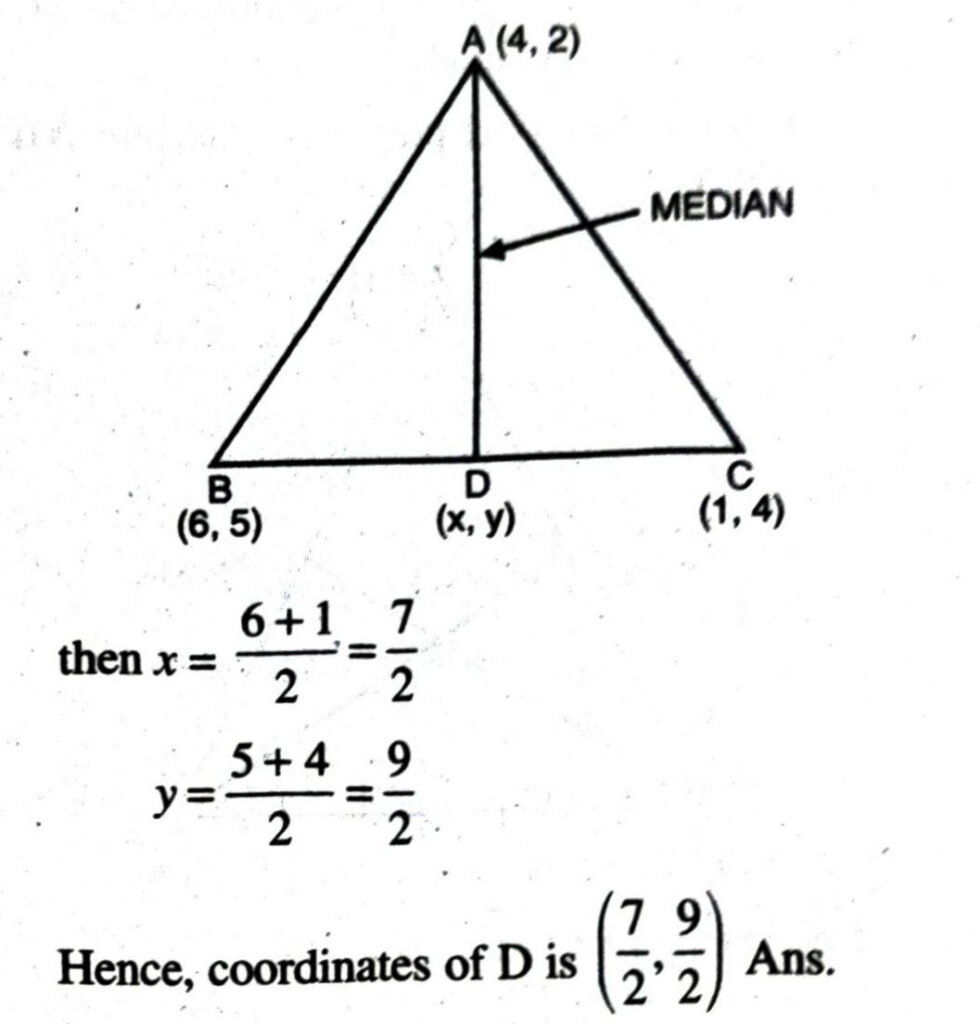
(ii) Let P (x, y) be point on AD such that AP : PD = 2:1
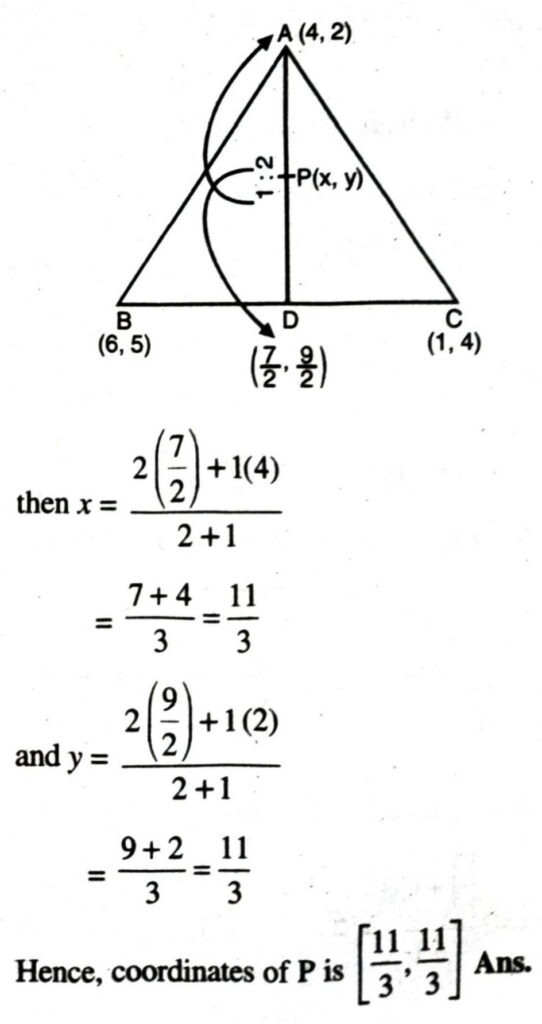
(iii) Let BE and CF are the medians of ΔABC to AC and AB respectively.
∴ E and F are mid points of AC and AB respectively.
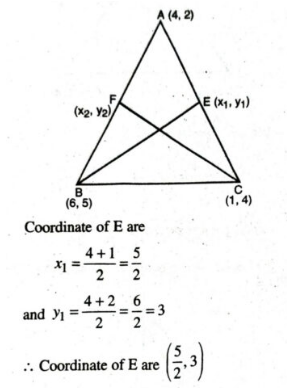
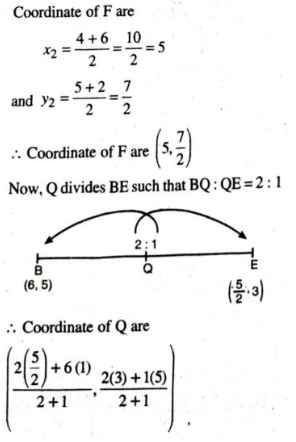
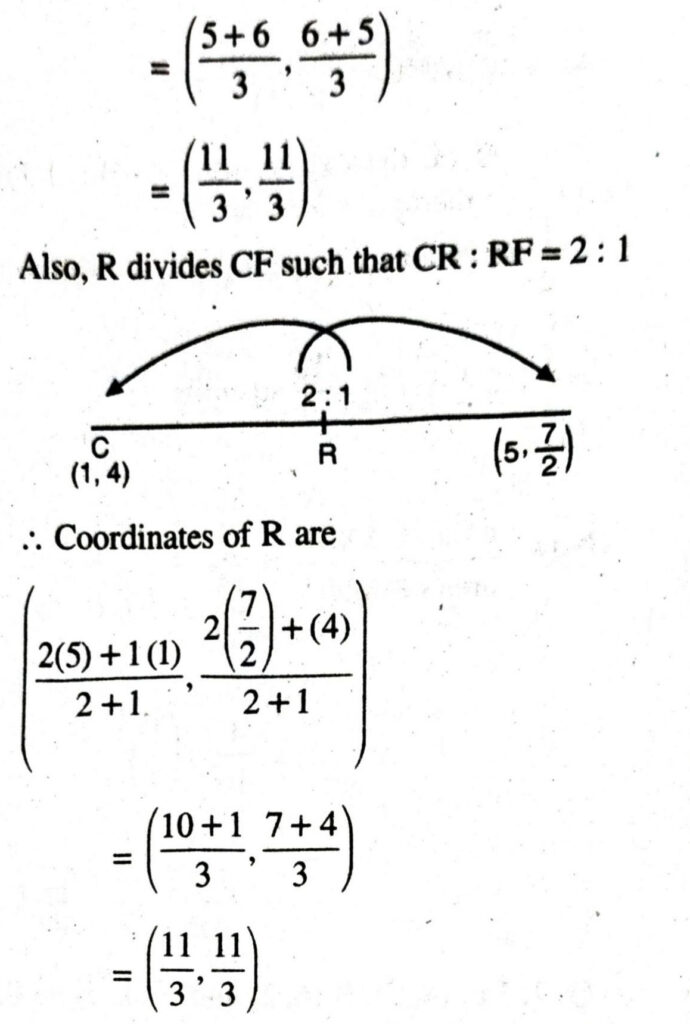
(iv) From above discussion, it is clear that coordinates of P, Q and R are same and coincide at a point, is known as centroid of triangle, which divides each median in the ratio 2 : 1.
(v) The vertices of given ΔABC are
A (x₁, y₁); B (x2, y2) and C (x2, Y3).
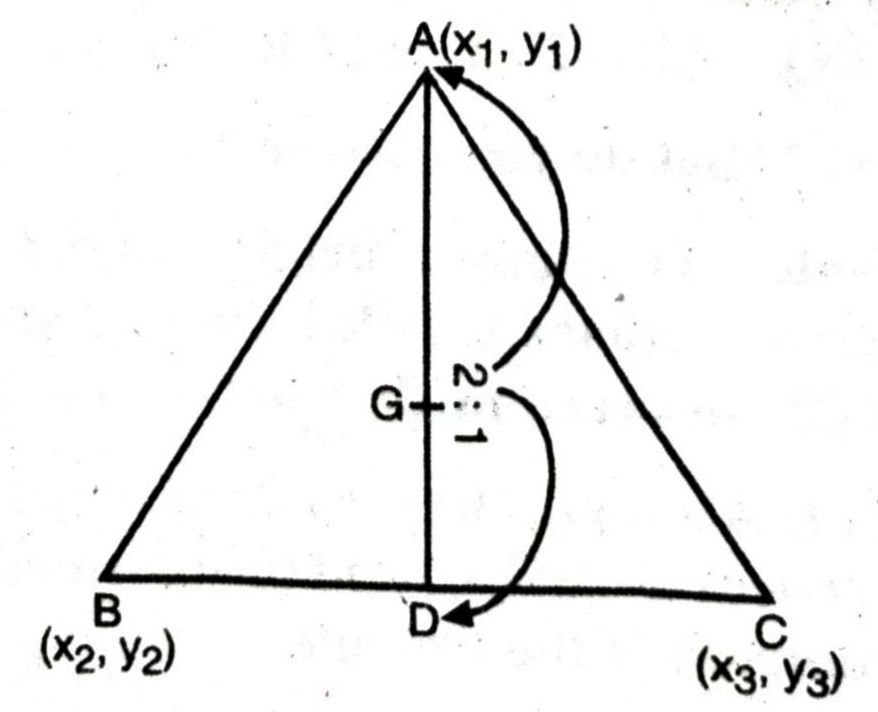
Let AD is mediam of ΔABC.
∴ D is the mid point of BC then coordinates of D are

Now, G be the centroid of AABC, which divides the median AD in the ratio 2 : 1
∴ Coordinates of G are [using (iv)]
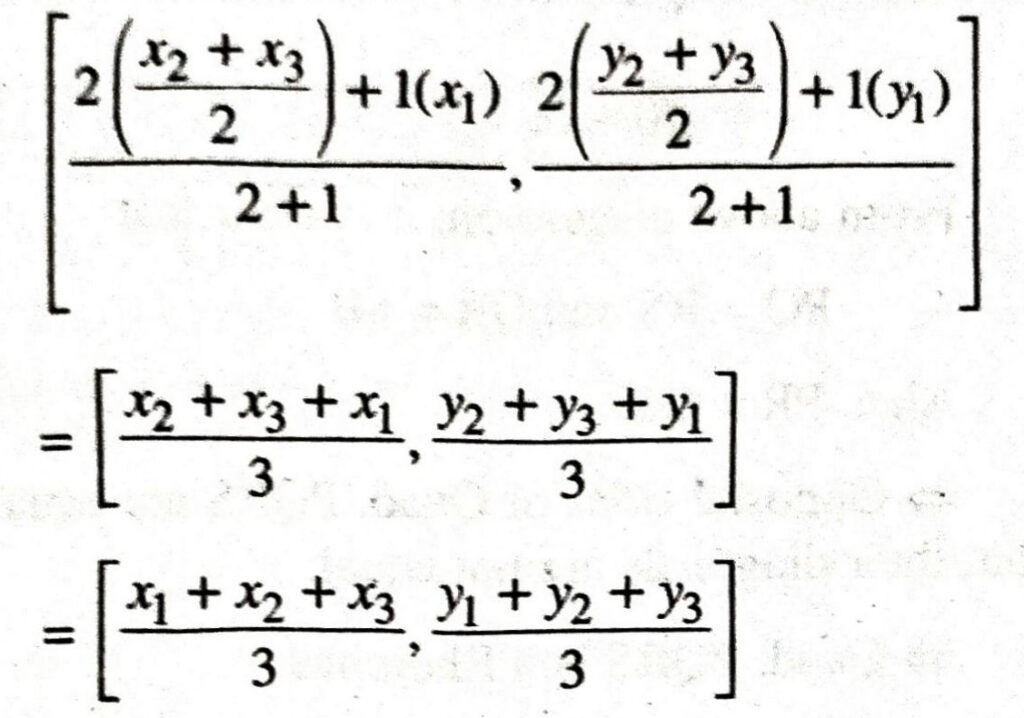
Q. 8. ABCD is a rectangle formed by the points A (-1, − 1), B (- 1, 4), C (5, 4) and D (5, -1). P, Q, R and S are the mid points of AB, BC, CD and DA respectively. Is the quadrilateral PQRS a square ? a rectangle? or a rhombus ? Justify your answer.
Solution.
Given. The vertices of given rectangle ABCD are
A(-1,-1); B (- 1, 4); C (5, 4) and D (5,- 1).
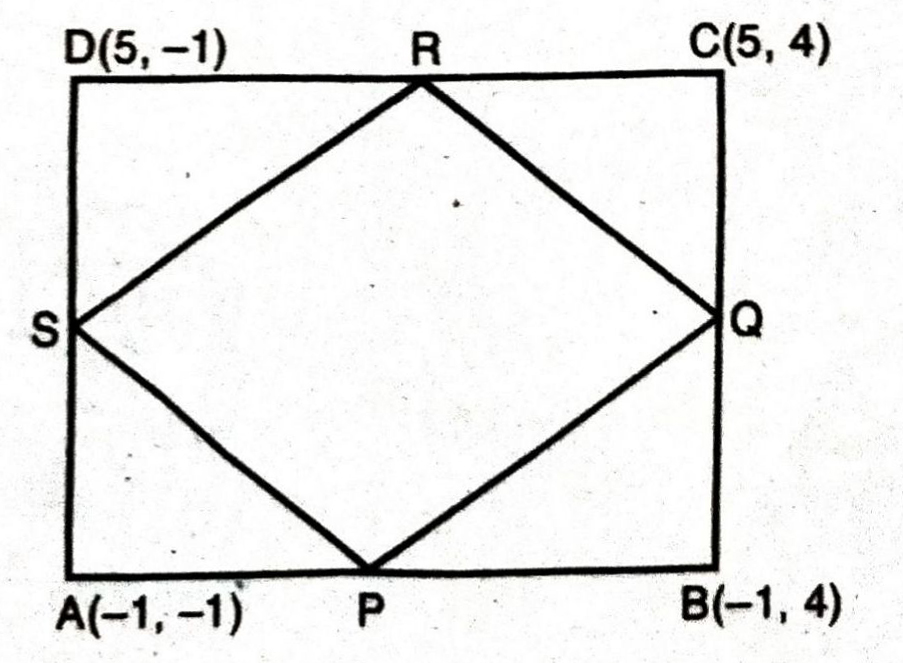
∵ P is the mid point of AB.
∴ Coordinates of P are
∵ Q is the mid point of BC.
∴ Co-ordinates of Q are

∵ R is the mid point of CD
∴ Coordinates R are

∵ S is the mid point of AD
∴ Coordinates of S are
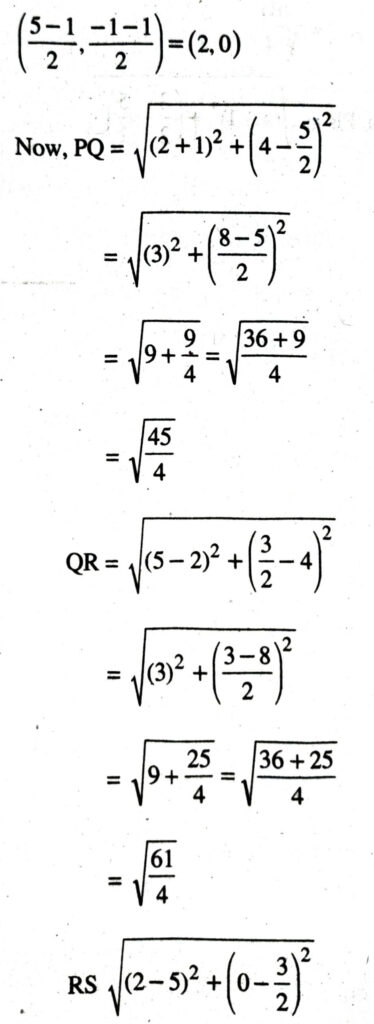
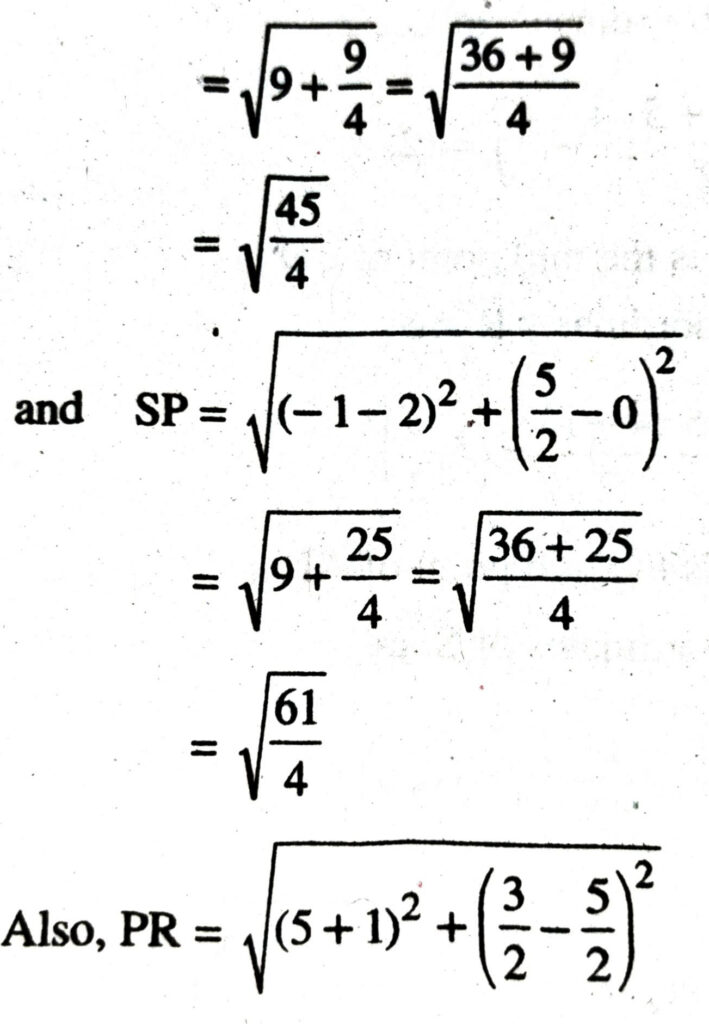
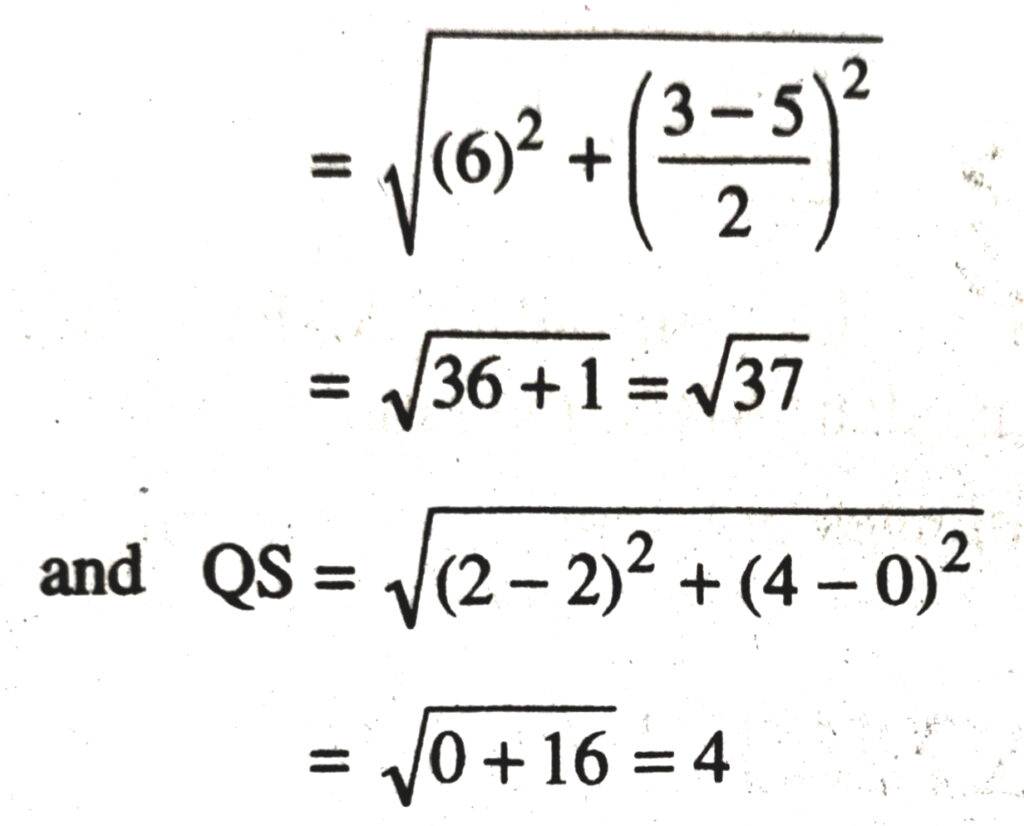
From above discussion, it is clear that
PQ = RS and QR = SP
Also, PR ≠ QS
⇒ Opposite sides of Quad. PQRS are equal but their diagonals are not equal.
⇒ Quad. PQRS is a Rhombus.
Follow on Facebook page – Click Here
Google News join in – Click Here
Read More Asia News – Click Here
Read More Sports News – Click Here
Read More Crypto News – Click Here